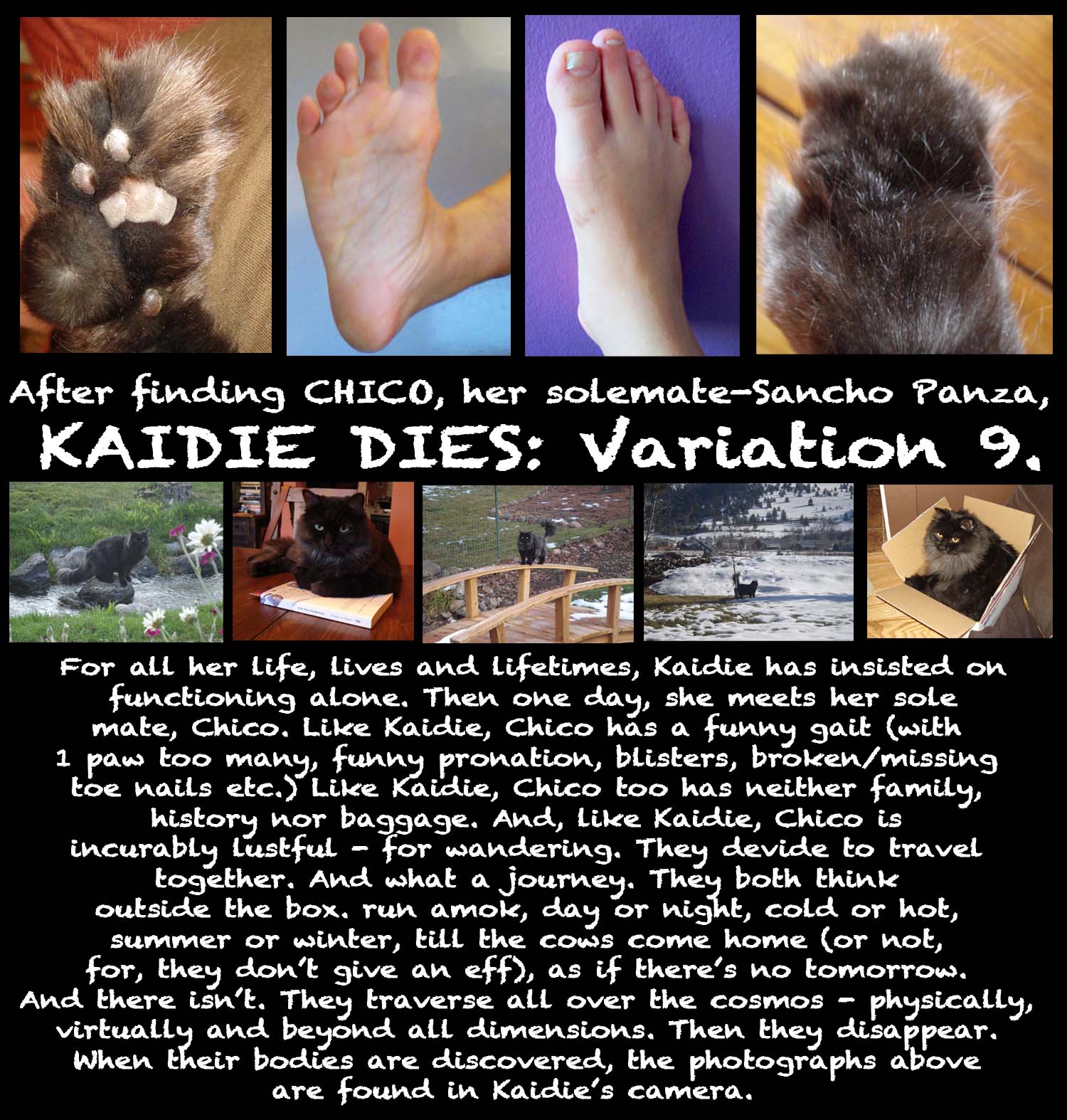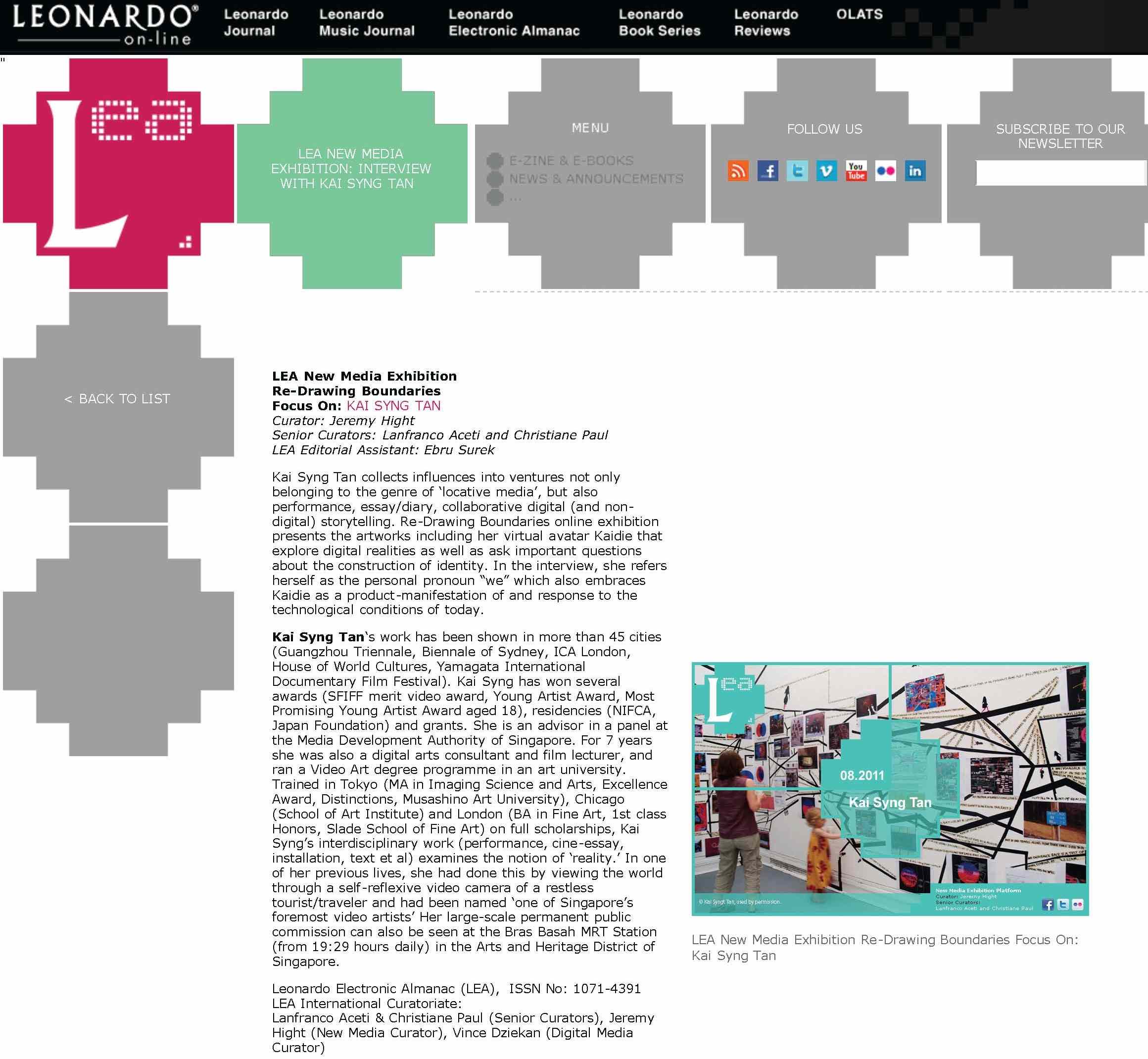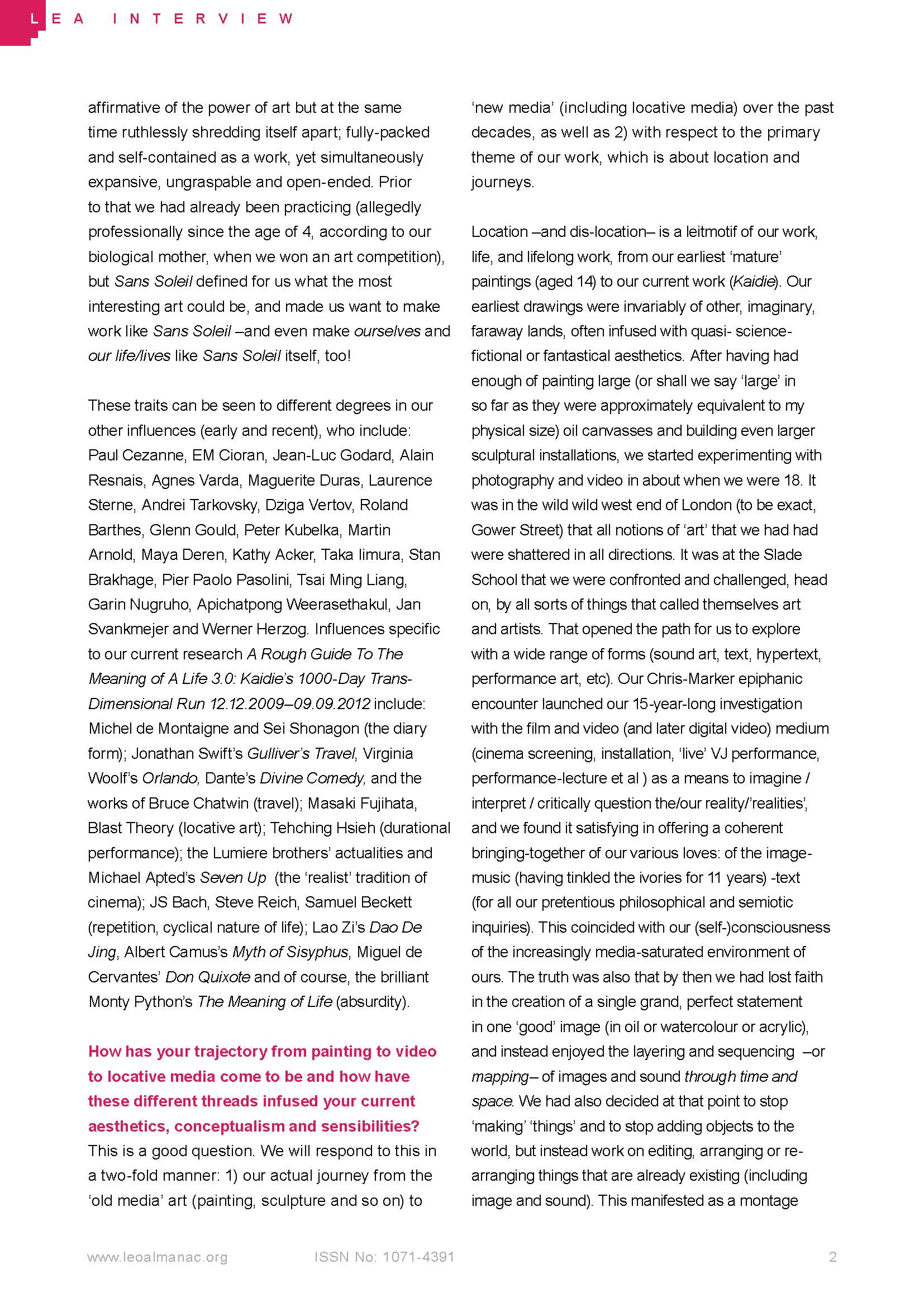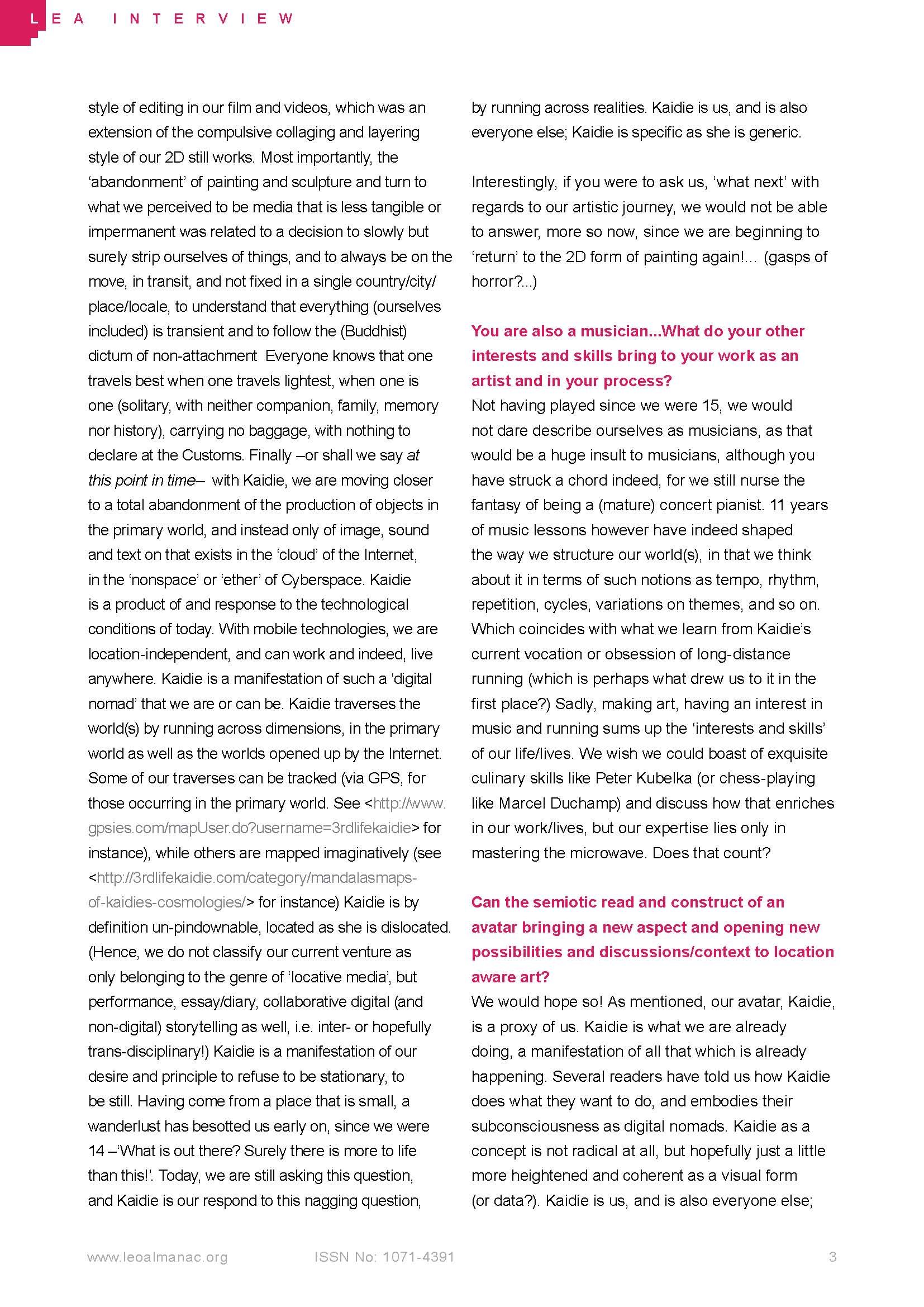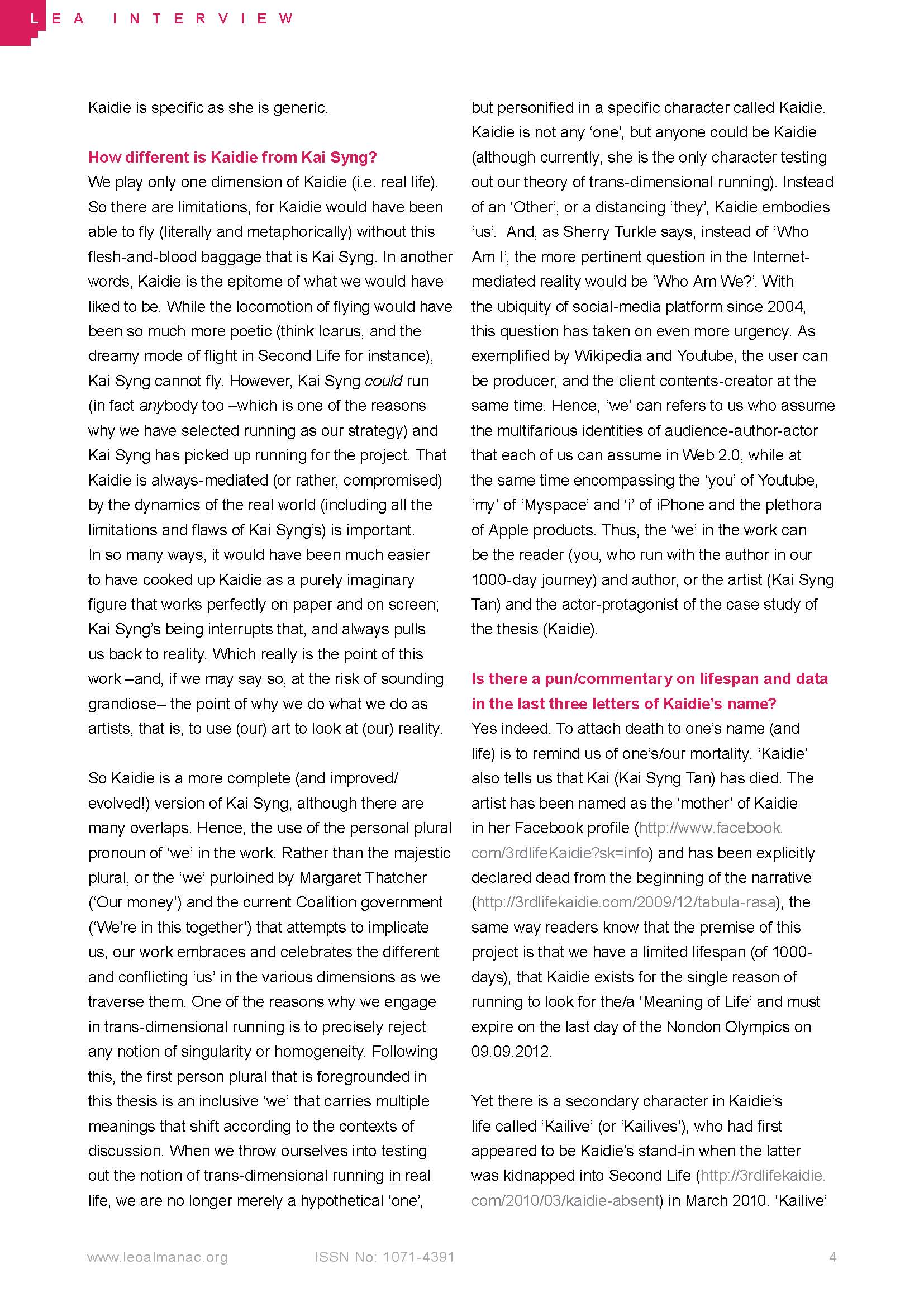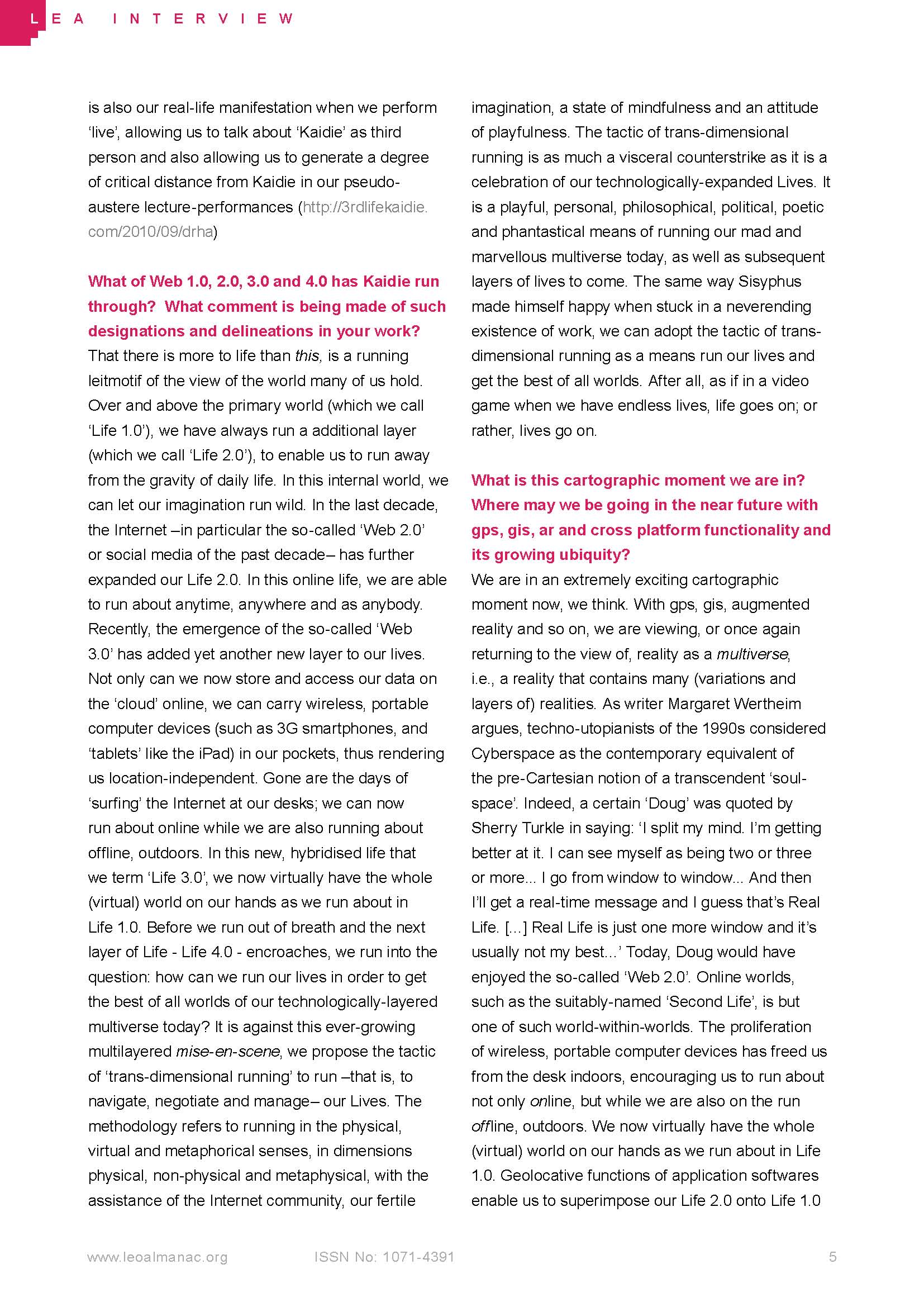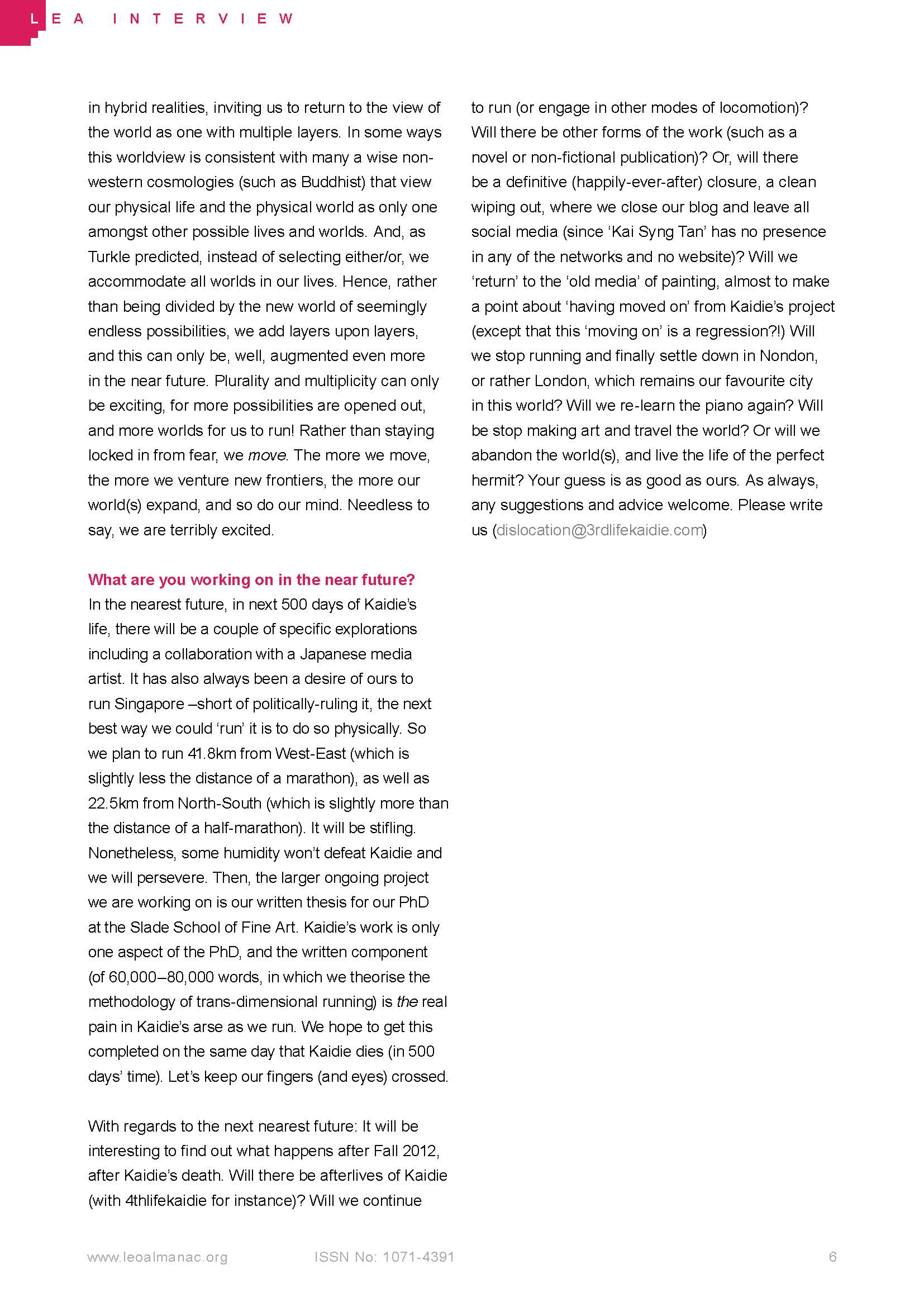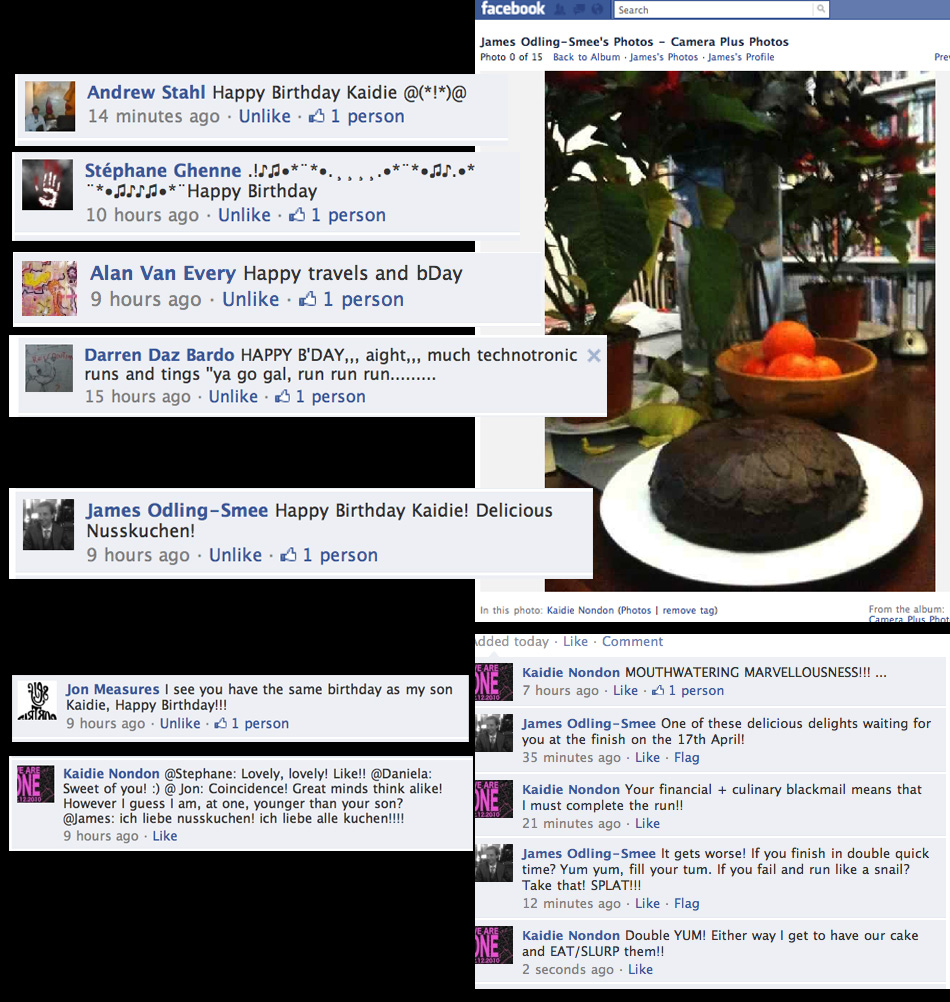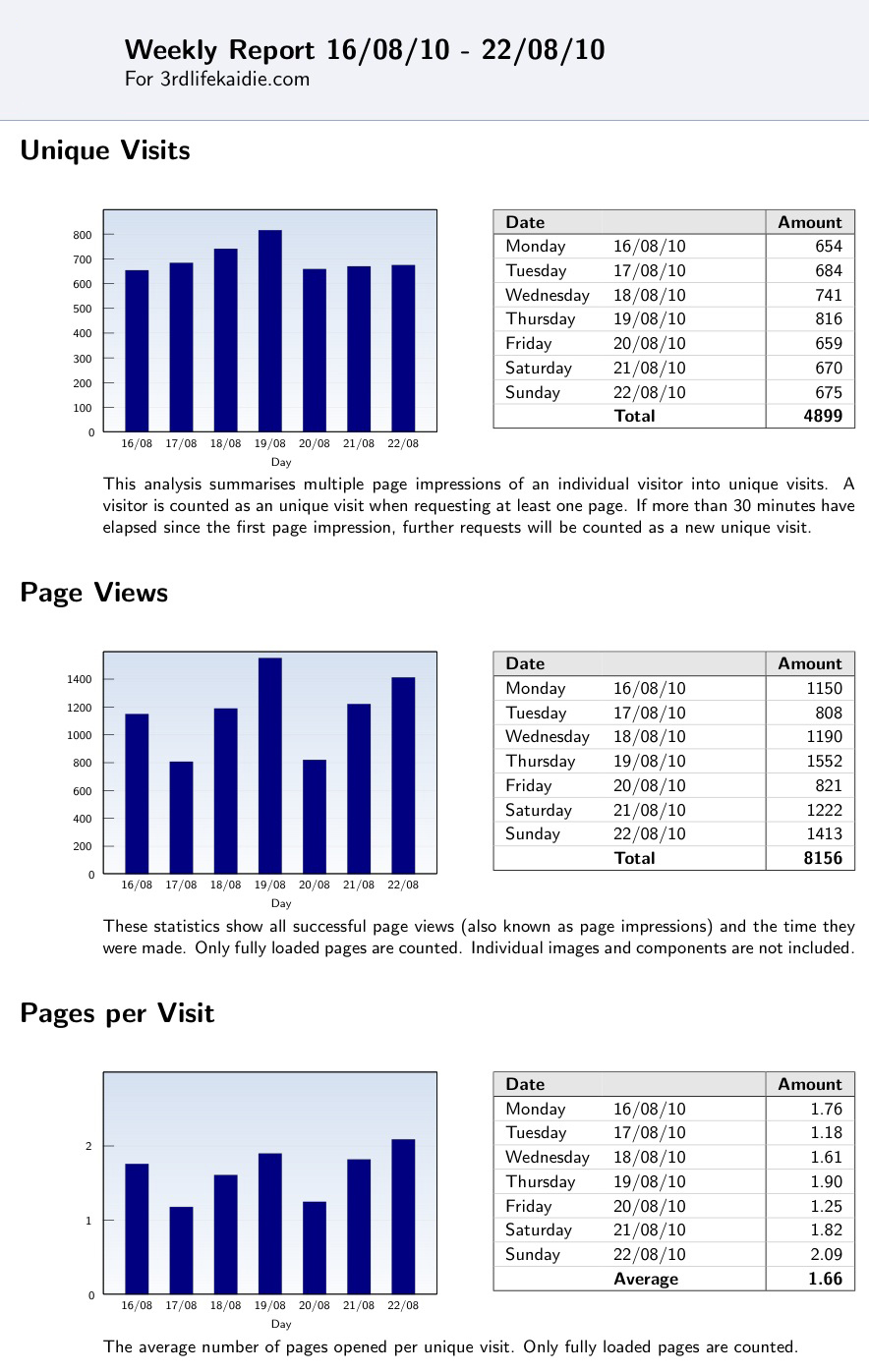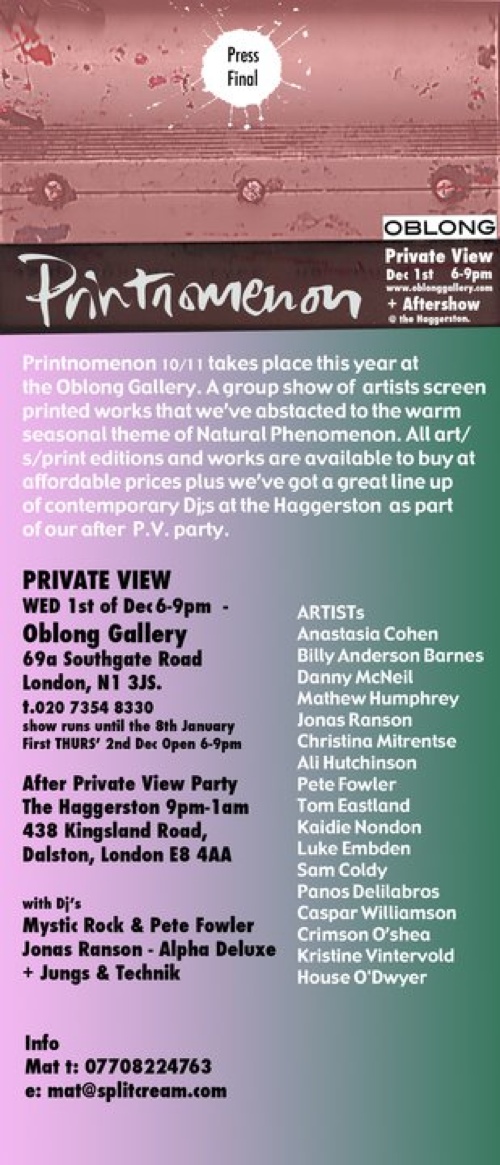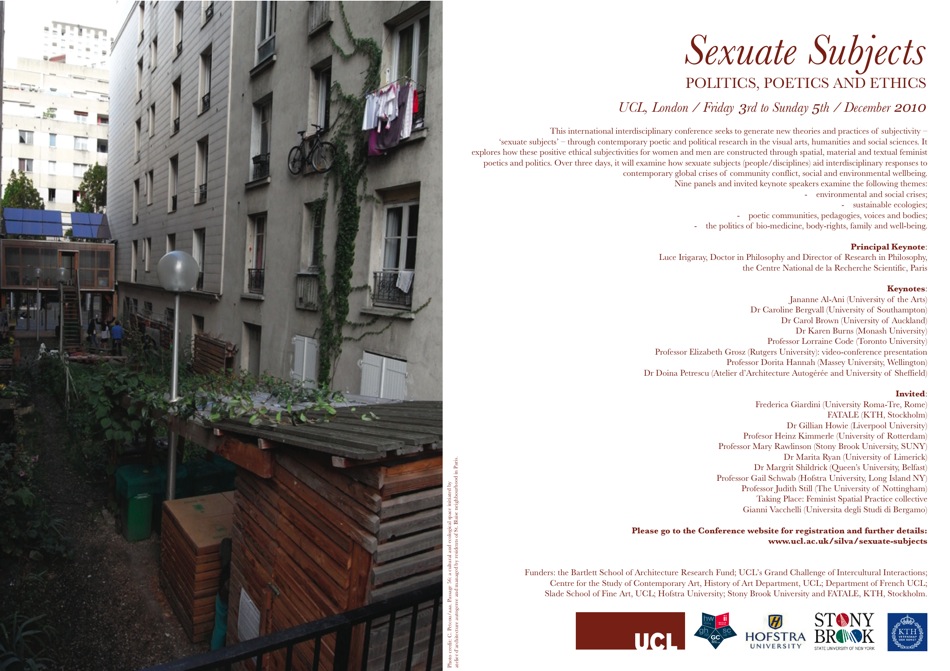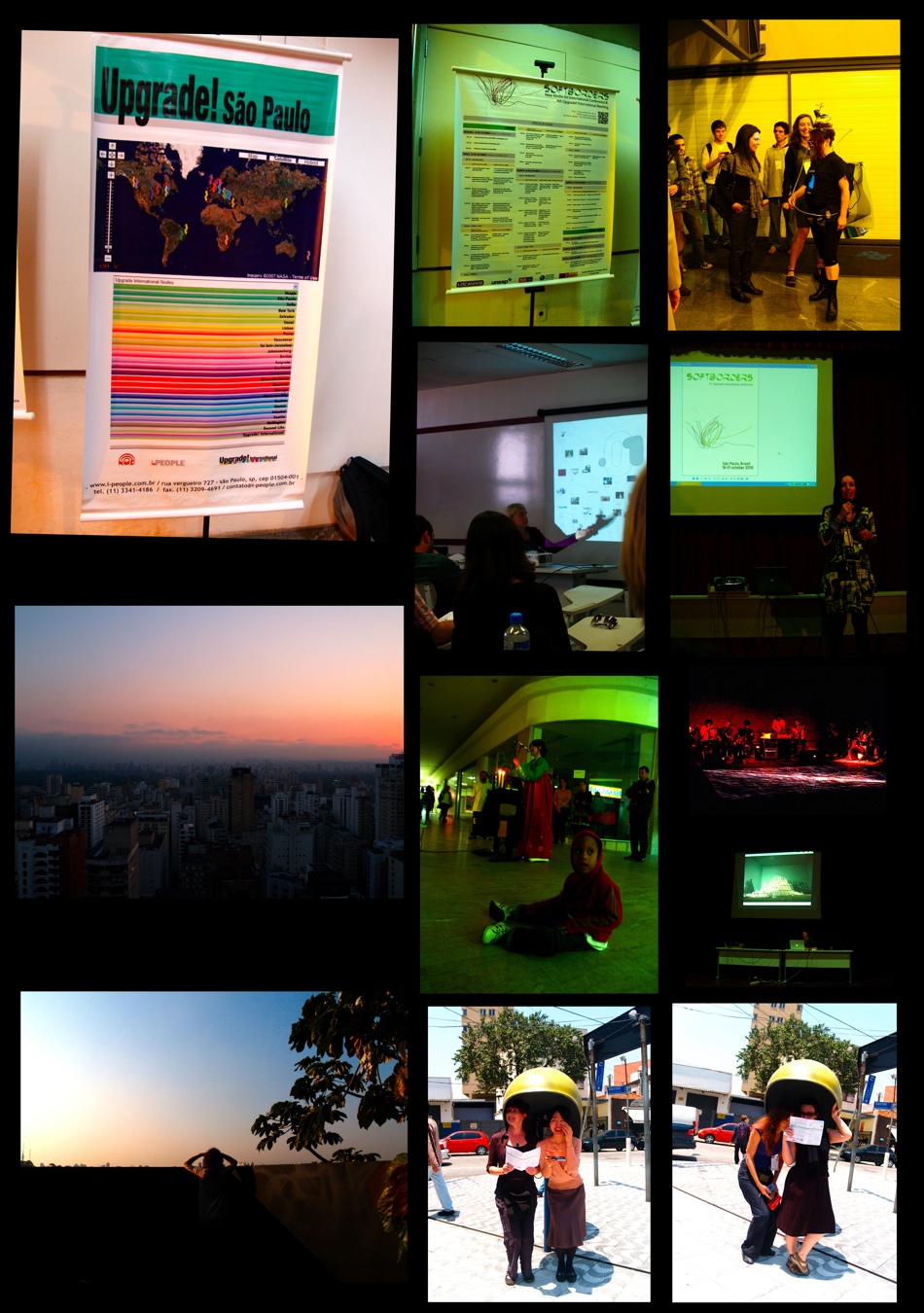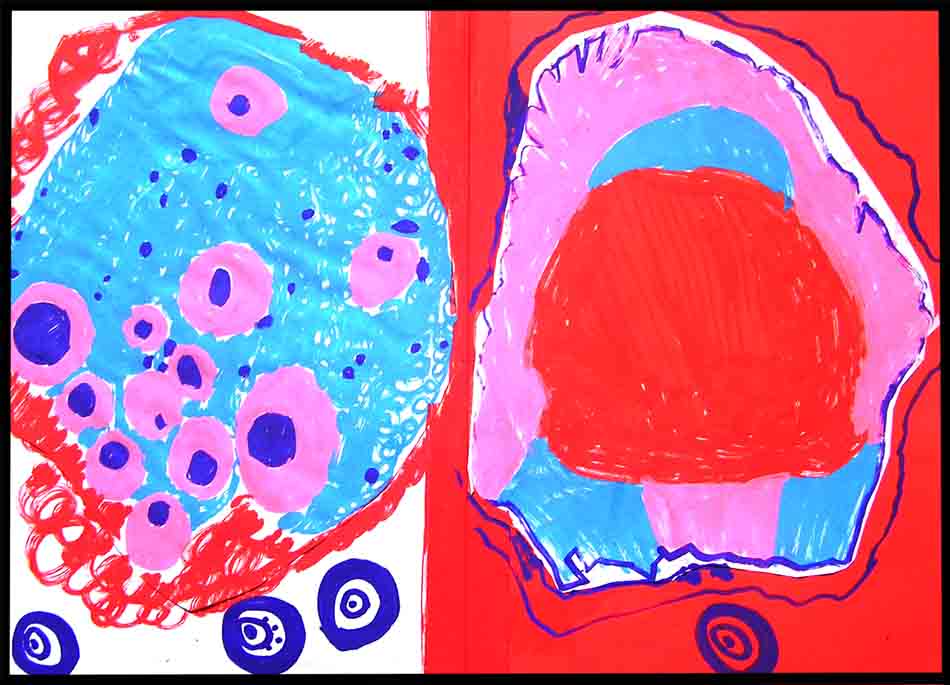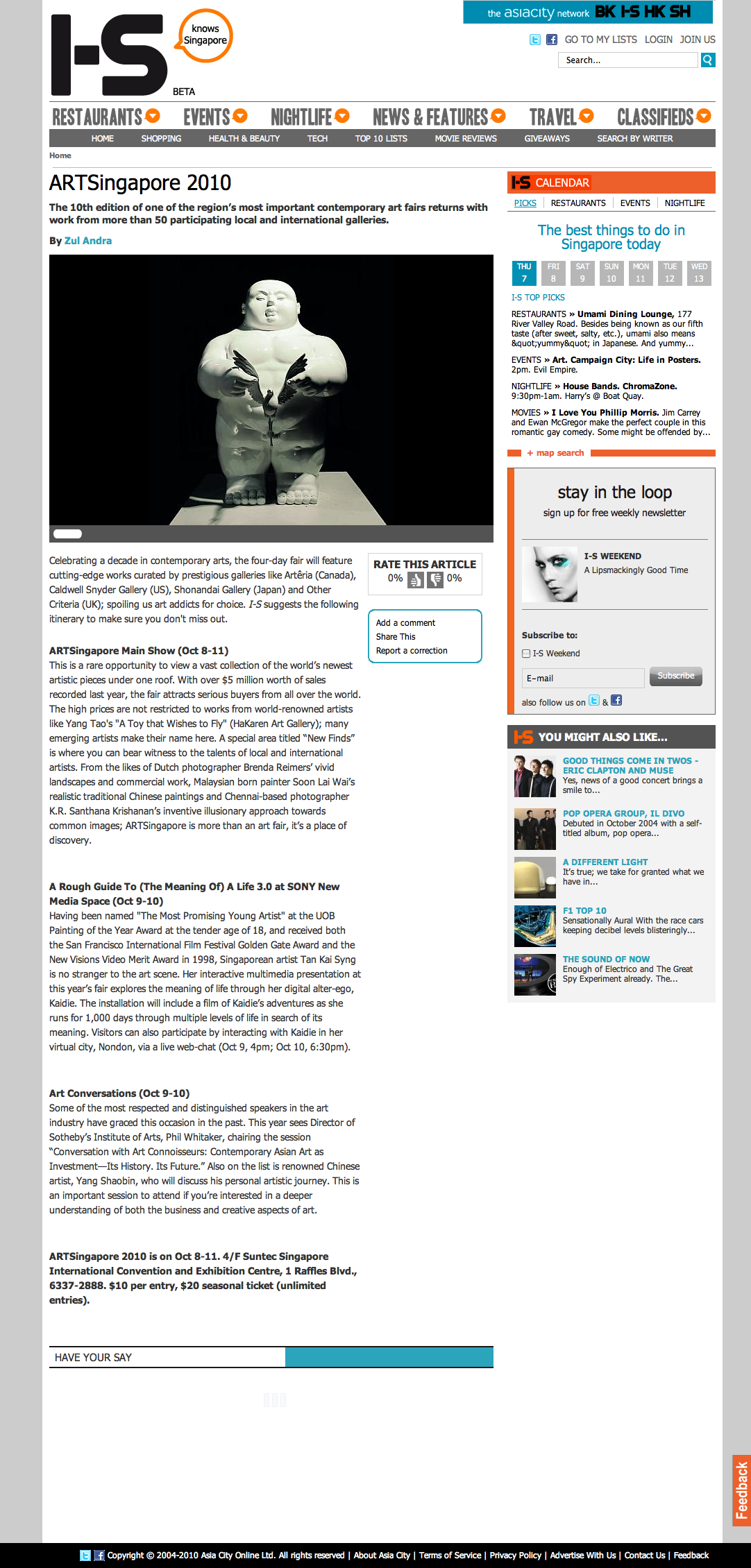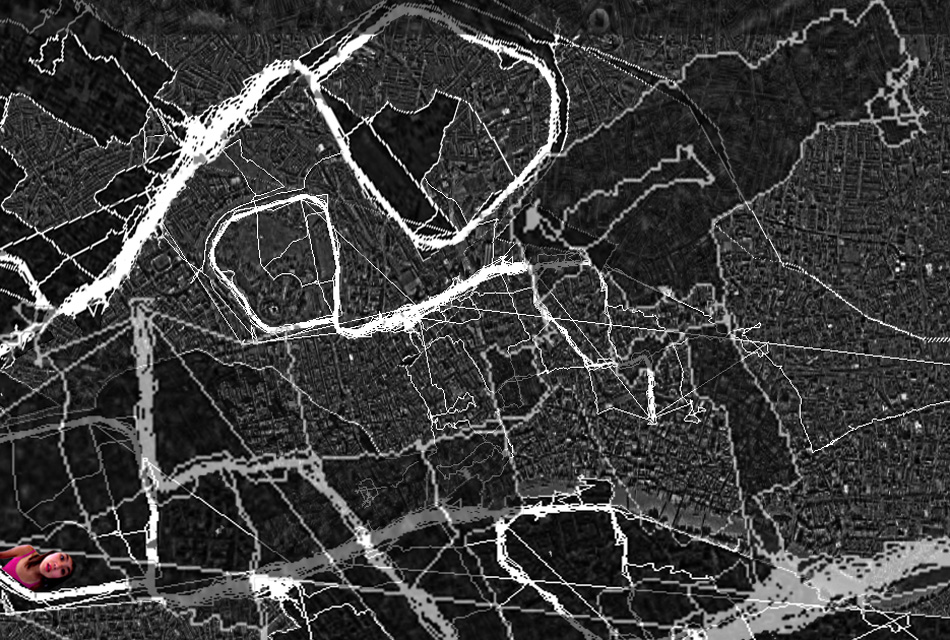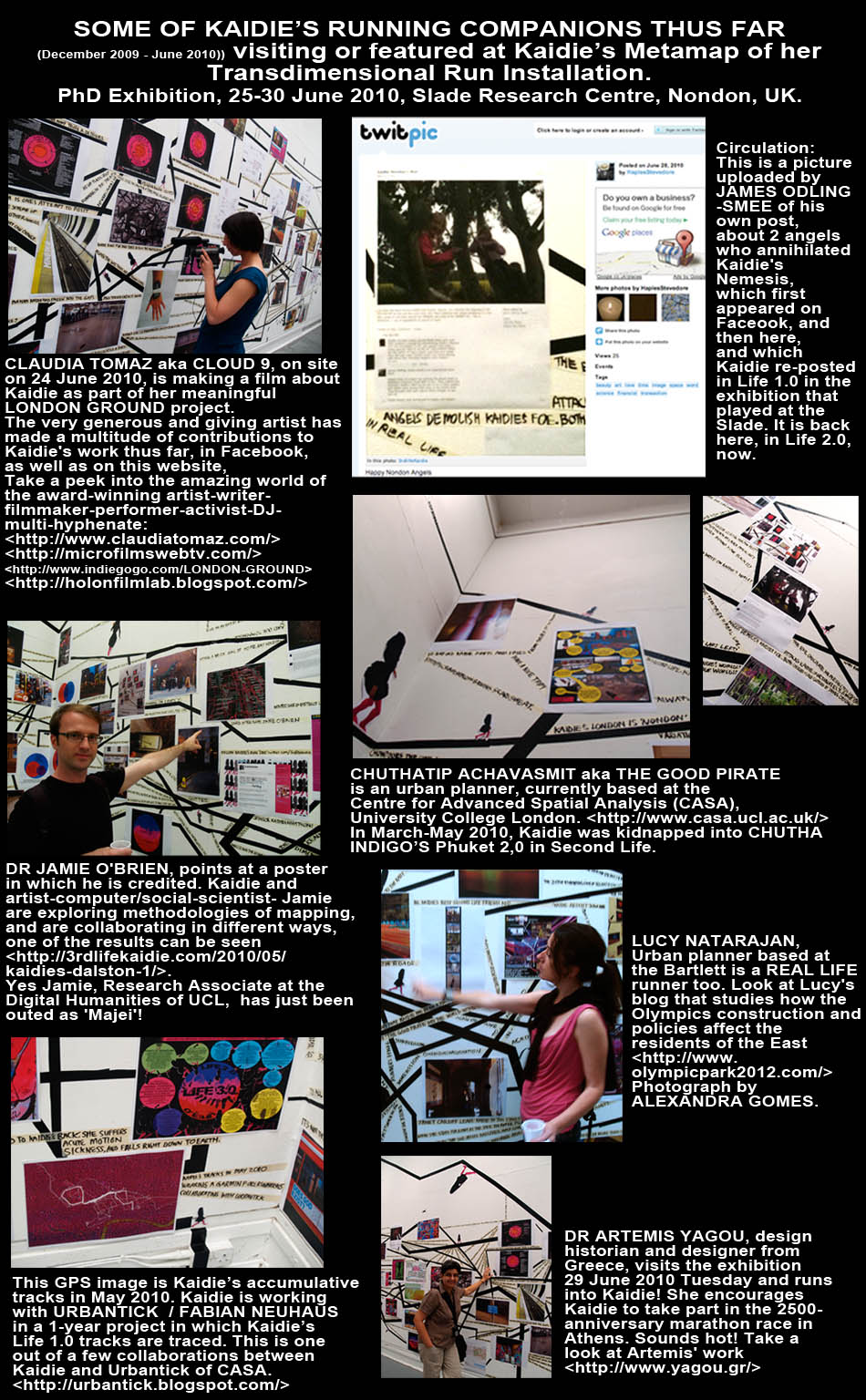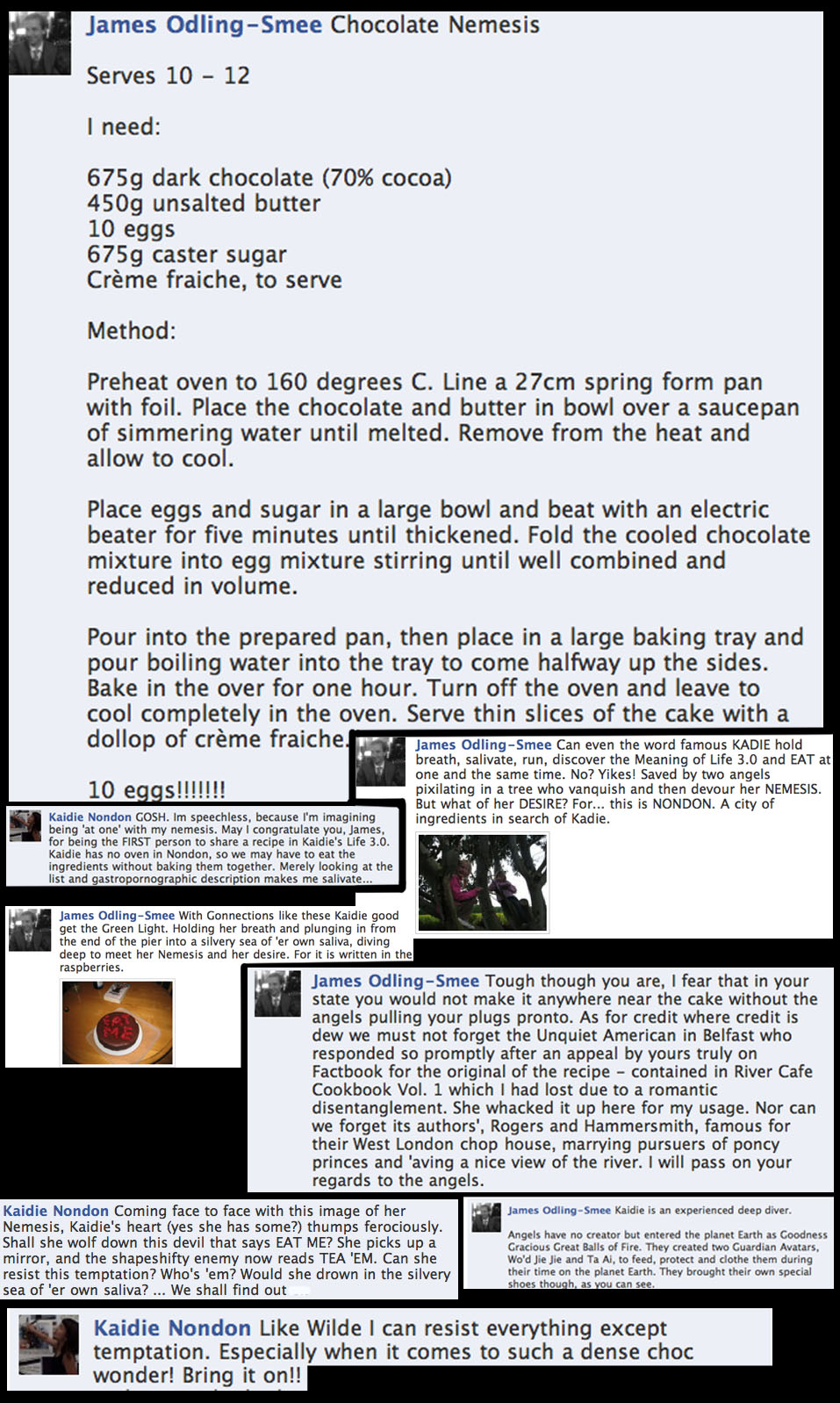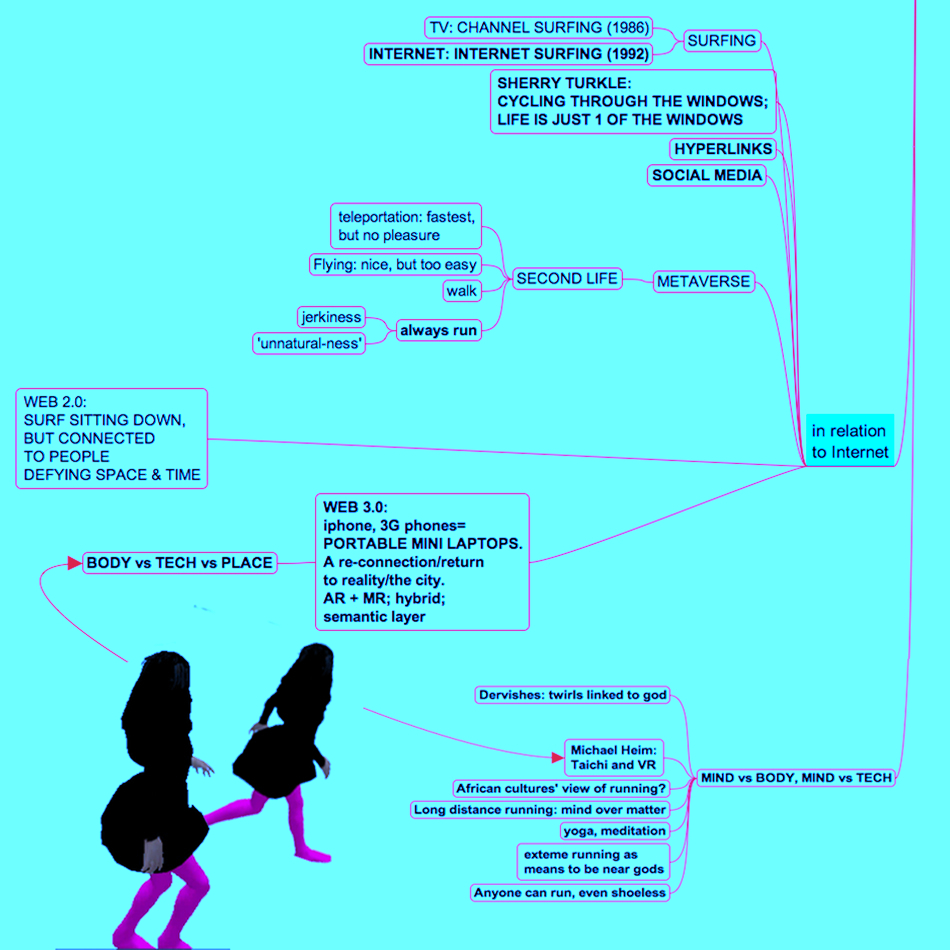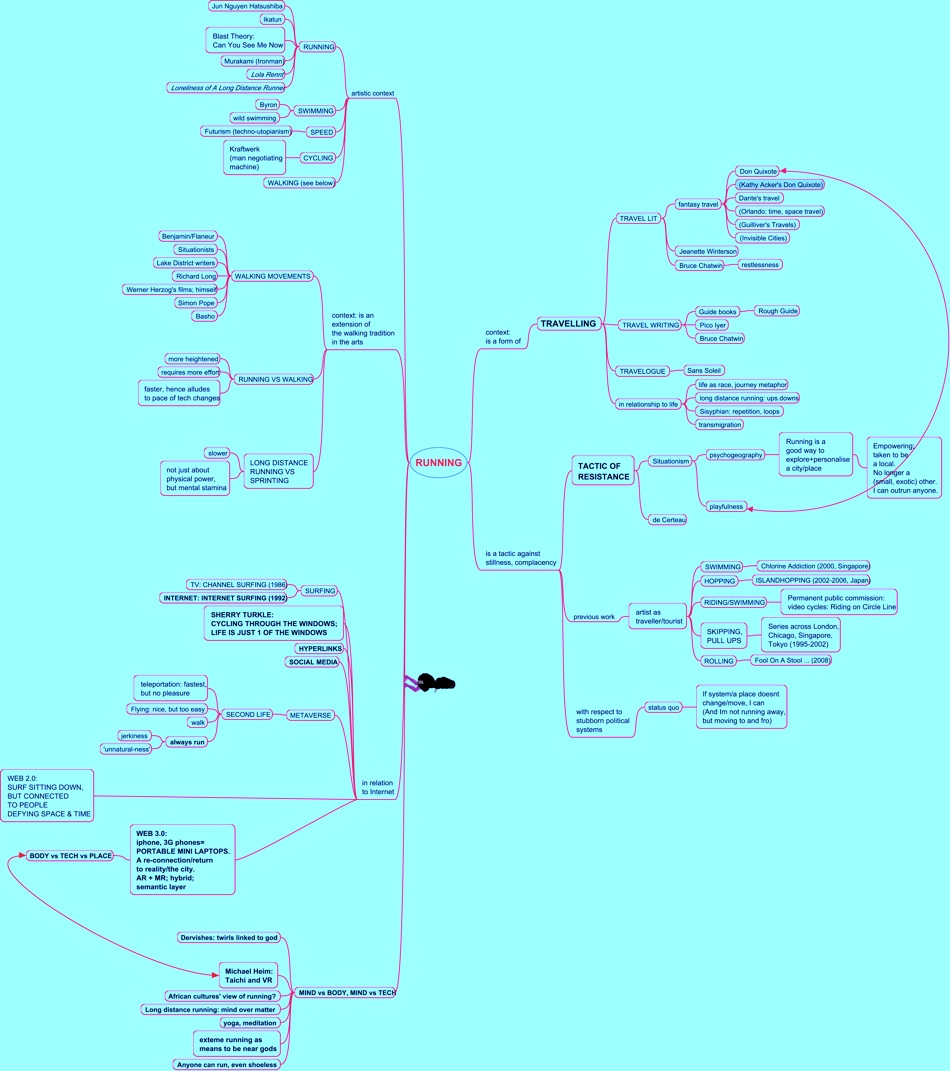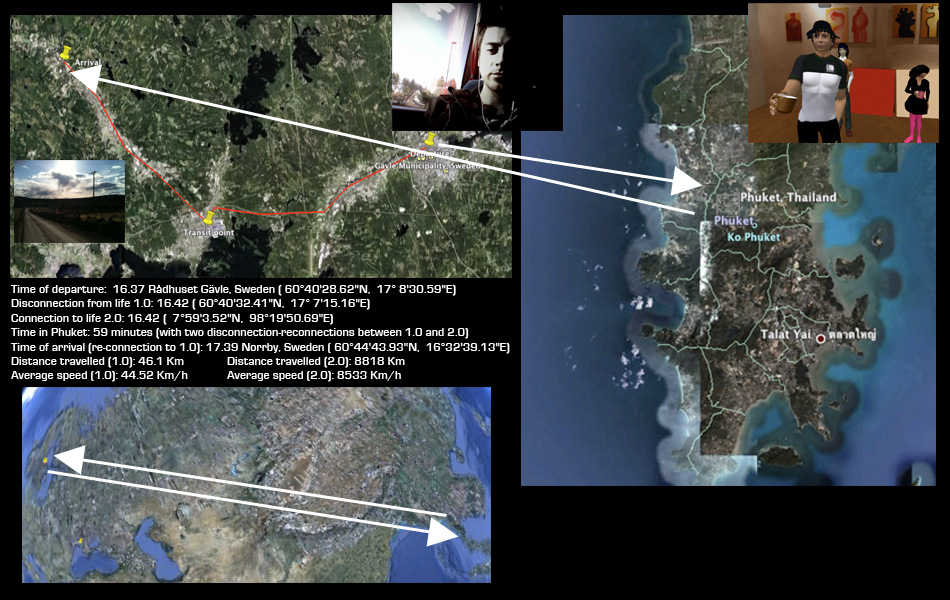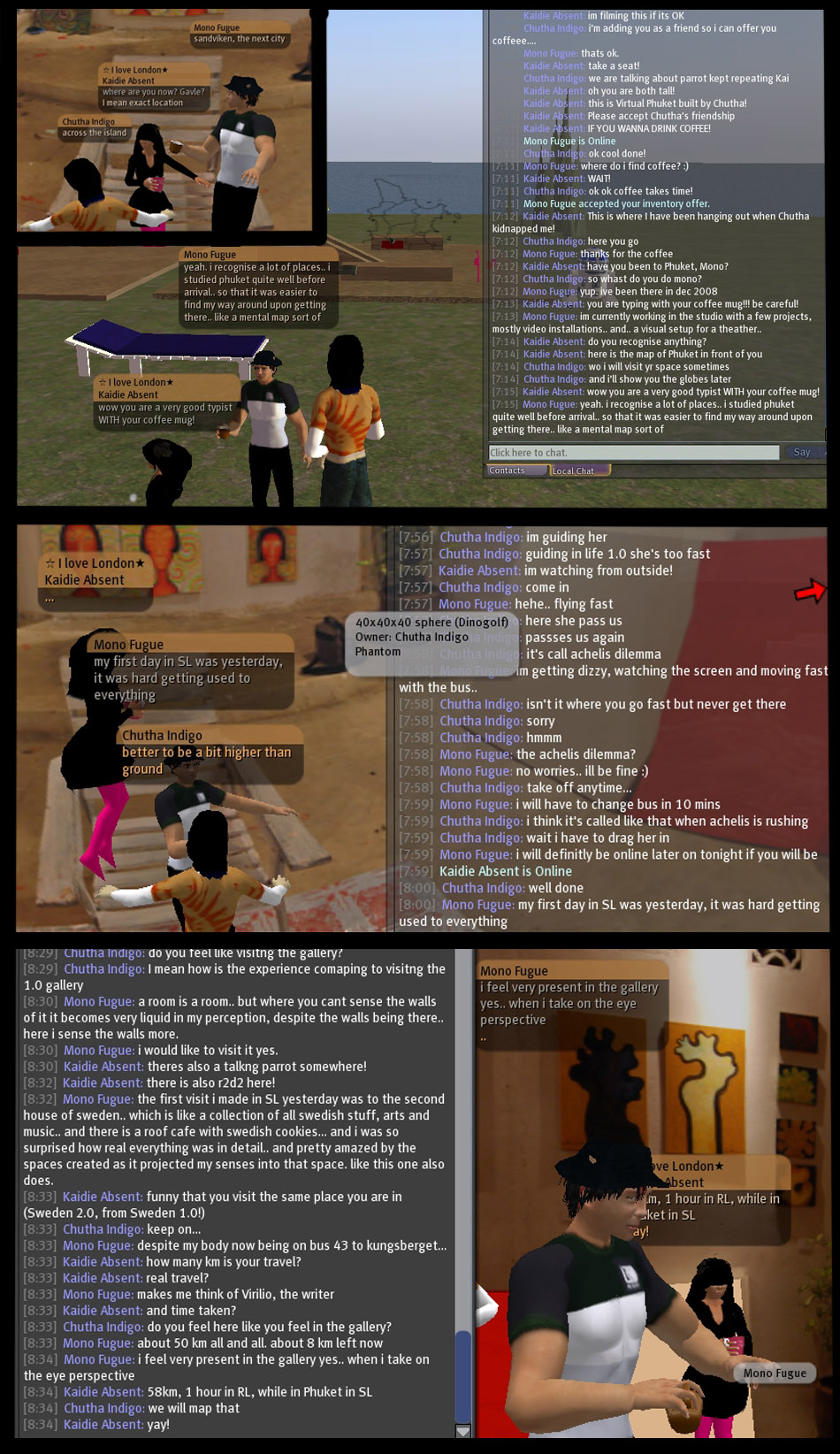KAIDIE DIES: Variation 9. Rest in Peace Chico! Carry on running.
We also found a note, that says ‘Many, many thanks to ANJI REYNER, Kaidie’s Facebook friend, for Chico’.
** KAIDIE MOMENTARILY RISES FROM HER GRAVE ON 1 AUGUST 2011 IN LIFE 2.0 ON LEONARDO ONLINE **
Kaidie has been momentarily woken up from her ongoing death on 1 August, with her participation in Re-drawing Boundaries, a LEA New Media Exhibition online. And it is completely the fault of curator-artist-writer-theorist-photographer-musician-weathernerd-cat-dad-all-rounded-all-rounder Jeremy Hight (whom Kaidie is acquainted with only via the evil Facebook). Hight’s senior conspirators are Lanfranco Aceti and Christiane Paul. Do visit the show and experience other locative media works by Teri Reub, Jeremy Wood amongst others! Kaidie thanks Hight, Aceti and Paul, and returns to her astral journeys.
THANK YOU OUR FRIENDS FOR YOUR WELL-WISHES FOR OUR FIRST YEAR OF EXISTENCE
On 12 December 2010, we marked our first year of existence. Here is a selection of some of the lovely messages we received from some of You:
So we have explained who ‘we’ are; now THIS IS YOU! … So there you are. Nice to meet you, too.
Just as running is an accessible undertaking, our tactic of trans-dimensional running can be utilised by anyone. Those who submit themselves to what William Gibson terms as the ‘consensual hallucination’ of Cyberspace, and those who cower in fear from the Digital Revolution alike, will find the tactic useful, too.
In our previous post, we have explained the use of the personal plural pronoun ‘we’ in our work. Now, the question is, who on googleearth are you?
Reproduced above is a section of our weekly report with regards to the audience-ship of this breathtaking running log /travel blog: So there are nearly 700 of unique you-s who read this blog daily; on some days there are only 821 pages viewed, while on others as many as double that (1552) pages get read. On average you read 1.66 pages each time, for a duration long enough for you to be registered as unique.
So there you are. That is as far as we are able to establish. We have no idea however with regards to your background, location, character, gender, height, weight, sense of humour (if any?), political view, world view, if you are passing by, or if you have run into this by mistake, or if you are a regular returnee running with us all this while, or if you are reading with disdain, spitting at your computer screen. You are probably a mixture of some of these.
Well, nice to meet you, too. We are Kaidie.
WHO AM ‘WE’? The use of the personal plural pronoun explained in this interview we had with Shiseido Singapore.
A couple of months back, Kaidie’s efforts were featured in an online site by the Singapore wing of the Japanese cosmetics company Shiseido, from which the images above are quoted. We also answered a few questions, which are reproduced here. The image of us above has been appropriated from another realm, before our birth, in October/November 2009, in an other interview.
Q: What’s your philosophy and attitude towards life?
Hello World. We are Kaidie, a trans-dimensional runner, looking for The/A Meaning of Life 3.0, by running for 1000 days within and across various dimensions of reality: ‘Life 1.0’ (the primary world – including the city of ‘Nondon’), Life 2.0 (the realm of imagination, as well as online realities made possible by ‘Web 2.0’), ‘Life 3.0 (the hybrid realities enabled by ‘Web 3.0 on our portable wireless devices), as well as ‘Life 4.0’ (the hypothetically-named ‘Web 4.0? and other future technologically-enabled realities, as well as other cycles of our lives to come). We die on the last day of the Nondon Olympics on 09.09.2012, so do join us on our quixotic quest! With this mission in Life, you can tell that we aim to live our Lives to the full, while we are here!
Q: Why Kaidie?
‘Kaidie’ is a variation of artist Tan Kai Syng; or rather, it is more accurate to say that Kai Syng is the Life 1.0, real life version of Kaidie. That said, Kaidie is also all of us out there: the users of the Internet, the people who go online in the time-space of ‘consensual hallucination’ (as William Gibson labels the Internet). So, Kaidie is one, but Kaidie is also many, and any one of us can be Kaidie. hence the utilisation of the plural personal pronoun of ‘we’. As Cyber-theorist Sherry Turkle says, instead of asking ‘Who am I’, the more relevant question is ‘Who Am We’ in the age of multiple identity today, which the Internet further magnifies (1996). Our ‘we’ embodies Kaidie, Kai Syng, Kai Die, Kailive, Kailives, Kaidie Absent. It also encompasses the ‘i’ of iPad, iPhone, iPod, and ‘You’ or Youtube, and You of the Times Magazine Person of the Year 2006, and or ‘my’ of Myspace. But this is not a homogenising we; neither is it the implicative Coalition ‘we-‘re-in-this-together’, nor the patronising Majestic Plural. Instead this ‘we’ includes the different shades of us, in different contexts. It’s an orgy which celebrates all variations of us!
Q: What do you hope to achieve and what’s next for Kaidie?
Kaidie runs to look for the Meaning of Life 3.0.Whether we succeed or not, we must die on the last day of the Nondon Olympics on 09.09.2012. At this point, we have about 670 days left, so we still have no clear idea of how we will die, or if we would succeed in our quixotic quest. With regards to the question of ‘what’s next’, we can only speculate: perhaps we will succeed in finding what we are looking for, and, as they say, ‘live happily ever after’, or rather, ‘die happily after’. Or, Kaidie might move on, literally and metaphorically, to the next stage of her life, and become ‘4thlifekaidie’! You, my dear Reader, can have a say in all this! Write in and give Kaidie advice on her journey, and contribute to her Lives, now and forever!
Q: Describe the most beautiful moment in your life.
In our short life in the past 11 months, there had been many beautiful episodes such as when we disappeared, one of our Facebook Friends offered prayers to look for us. We believe that there will be more beautiful moments to come in the next 670 days, so do look out for it with us!
DO COME TO OUR 2 (OUT OF 4) OF OUR GIGS IN NONDON THIS WEEK!
This week, we are conducting 4 presentations – 2 of which you are cordially invited to! As for the other 2, we will tell you about them later – depending on how they go, that is. At press time, however, these other 2 gigs are state secrets…
** LATEST: We are running the 2011 Nondon Marathon on the 17th of April for Shelter, and will need YOUR help to raise £1600! ! TO MAKE A DONATION CONTACT US at <dislocation@3rdlifekaidie.com> THIS AND ONLY THIS CAN SECURE OUR FRIENDSHIP (or ‘friendship’) – we will run FOR YOU – what more can you ask of us?? **
2) Performance: Saturday 3 December 11:30hrs-12:30hrs. Part of the Sexuate Subjects Conference 2-4 December.
We are putting up a short ‘live’ performance at Sexuate Subjects: Politics, Poetics and Ethics, held at the University College Nondon. This conference brings together high-profile speakers from all over the world, to response to feminist Luce Irigaray‘s ideas. There is an entry fee to participate in this conference – to register please look here.
There you go. Hope to see you– soon(er) or later.
By hook or by crook.
One way or another.
This way or that.
Every now and then.
Here or there.
Online or off.
This year or the next.
This life, or the next.
Till then.
UPDATABLE GLOSSARY: YOU & I & US
GLOSSARY/ WIKI ABOUT THE UNIVERSE OF KAIDIE / LIFE 3.0,? AND THE THEATRE OF CHARACTERS (ongoing). SEEKING DEFINITIONS AND MULTIPLE + ALTERNATIVE DEFINITIONS! CONTRIBUTE NOW!
THEATRE OF PLAYERS IN THIS UNIVERSE- INCLUDING YOU!
* Audience:
* Author:
* Artist:
* Reader:
* User:
* Player:
* Producer:
* You:
* Me:
* We
* Antagonist:
* Protagonist:
* Your avatar(s):
* My avatar(s):
* Your online proxy:
* My online proxy:
* Your online proxies:
* Our online proxies:
* Your offline proxy:
* My offline proxy:
* Our offline proxies:
* Collaborator:
* Co-author:
* Conspirator of Pleasure:
* Co-runner:
*Running buddy:
* We are in this together:
RUNNING THE NEXT LAPS OF THE LONG-RUNNING BODY vs MIND vs TECHNOLOGY vs SOUL DISCOURSES. Trans-dimensional running as a critical strategy for our techonologically-layered multiverse.
Trans-dimensional running is as much a visceral counterstrike as it is a celebration of our technologically-expanded lives. As we run trans-dimensionally, we embody both the techno-utopianist Cyborg as well as the fragile, flesh-and-blood animal. We have one foot embedded in the physical world, and the other afloat in the non-physical and metaphysical worlds, detached from worldly matters. Technology permeates the activity of running, as it does in almost every aspect of our lives today. Yet, running could arguably be an act that utilises the least technology. In its most unembellished form, practitioners can run shoeless[1] – and indeed naked, as Pheidippides did 2500 years ago. Trans-dimensional running is a simple means of navigation in the digitally-saturated reality today. Running across the varied topographies, no one is in a better position than the trans-dimensional runner to tease out the long-existing as well as current debates of the battles between body, mind and technology. The undertaking of any endurance sport is a training of not only physical but mental resilience. In exercising our body and mind to revel and wrangle with our technologically-enhanced realities, the trans-dimensional runner has one foot in a techno-utopianist delirium (Clay Shirky et al), the other in a scepticism (Michael Zimmer et al). Running is a visceral counterpoint to the relentless development of technology. Web 2.0’s (somewhat ironically-named) social media was constructed by and for the geek –socially dysfunctional in Life 1.0– to virtually do virtually everything online without ever leaving one’s chair (or flat). While we celebrate our newfound ability to leave our bodies behind and run off into metaverses online,[2] pounding the pavements in meatspace immediately pulls us back to earth (and nature), reminding us the presence and limitations of our flesh-and-blood machines, and, indeed, our mortality.
And to the snobs (invariably bound to the armchair) who say that running is unthinking, one’s mind must work as actively as one’s body when one is running, as runners and sport psychologists attest.[3] When the body hits the metaphoric wall, only willpower and imagination can propel the runner to complete the last 6 miles of a 26.2-mile race.[4] When the body undergoes extreme states of duress, the chemicals in the brains pushes the runner into an altered state of consciousness.[5] At an optimal level, this can be the proverbial ‘flow’, a notion of focused motivation put forward by psychologist Mihaly Csíkszentmihály. As Daniel Shiffman, creator of open-source software Processing says, ‘I do all my best programming while jogging.’ [6] We also do not forget that Alan Turing, who was a highly-accomplished marathon-runner,[7] was said to have invented the beginnings of the computer in the middle of a run.[8]
Who better than the mythical ‘Marathon Monks’ of Mount Hiei, Japan, to refer to in the discussion of the importance of the lucidity of the mind (and spirit) when the body runs? While we are not unfamiliar with ascetic feats that humans are capable of in the bid to attain enlightenment (as seen in the fervent twirling of the Dervishes, and the practice of fire-walking of Hindus, just to name a few), the achievement of these monks still seem out of the world. The tofu-eating monks of the Tendai sect chant – while carrying scriptures, and running and walking for a total of 1000 days across a period of 7 years, in a practice called the kaihogyo. Running the equivalent of 2 marathons daily for a large part of the task,[9] the monk must cover a total distance of around 40,000 kilometres, equivalent to 1000 marathons.[10] In an exercise that already sounds like no walk in the park, the monk must go without food, sleep and drinks for a stretch of nine days as well.
Talk about effort. Perhaps those self-proclaimed Cyborgs and Cyborg-lovers (Donna Haraway, as well as the Orlans and Stelarcs) – could come out of their ivory towers and learn from the practice that has begun since the 18th century, which has feet firmly on the ground, while reaching for (self-) transcendence. Our ‘1000-day run’ is a mockery to the phrase when compared to this extraordinary synthesis of the mind, body and spirit…
[1] Vijai Singh, Barefoot Running – Video Library – The New York Times [accessed 12 July 2010]. In this video, we see that the writer of Born to Run: The Hidden Tribe, the Ultra-Runners, and the Greatest Race the World Has Never Seen, Professor Christopher McDougall also runs barefeet.
[2] Tim Guest, Second Lives (Arrow Books Ltd, 2008) p. 355.
[3] Such as Costas Karageorghis, ‘Sport Psychology: How Mental Imagery and Self-Hypnosis Can Improve Performance’, Peak Peroformance: Sporting Excellence [accessed 25 September 2010].
[4] As Barry Magee, bronze winner of the marathon in Rome, 1960 says, ‘(a)nyone can run 20 miles. It’s the next six that count.’ Quoted in ‘Running Quotes | Training & Racing’, Run the Planet: World Wide Resource for Runners, 1996 [accessed 24 September 2010].
[5] As discussed in such literature as Henriette van Praag, Gerd Kempermann and Fred H. Gage, ‘Running Increases Cell Proliferation and Neurogenesis in the Adult Mouse Dentate Gyrus’, Nat Neurosci, 2 (1999), 266-270.
[6] Daniel Shiffman, Learning Processing: A Beginner’s Guide to Programming Images, Animation, and Interaction (Morgan Kaufmann, 2008), p. xii.
[7] Although Turing did not manage to be selected for the 1948 Olympics, having come in fifth, his best time of 2 hours, 46 minutes, 3 seconds, achieved in 1947, was only 11 minutes slower than the winner in that Olympic Games. John Graham-Cumming, ‘An Olympic Honour for Alan Turing | Comment Is Free | Guardian.co.uk’, 2010 [accessed 5 July 2010].
[8] According to 1968 Boston Marathon winner Amby Burfoot in the foreword (p. ix), in Michael W. Austin, Running and Philosophy: A Marathon for the Mind (Wiley-Blackwell, 2007), p. 135.
[9] Jayne Storey, ‘Running Buddhas. Ultra-Endurance and the Spiritual Athlete’ [accessed 10 July 2010]. According to Storey, the full menu of the monk’s 10000-day feat, the Sennichi Kaihogyo, is as follows: ‘1st year: 100 consecutive days of 26.2-mile marathons, beginning at 1:30 a.m., each day after an hour of prayer. 2nd year: 100 consecutive days of 26.2 mile marathons. 3rd year: 100 consecutive days of 26.2 mile marathons. 4th year: 100 consecutive days of 26.2 mile marathons – performed twice. 5th year: 100 consecutive days of 26.2 mile marathons – performed twice. On the 700th day, the monks undergo a 9 day fast without food, water, rest or sleep – a mind-boggling feat which would result in certain death for most human beings, before having a short rest of a few weeks and increasing their gruelling schedule. 6th year: 100 consecutive days of 37.5 mile marathons. 7th year: 100 days of 52.2 mile marathons and 100 days of 26.2 mile marathons.’
[10] Anthony Kuhn, ‘Monk’s Enlightenment Begins With A Marathon Walk’ (NPR, 2010) [accessed 11 July 2010].
Images on this page are photographed by Michael Larsson.
CHAT WITH KAIDIE ‘LIVE’ SATURDAY 16:00hrs + SUNDAY 18:30hrs (Singapore time)! We’re at ‘kaidie3rdlife’ on Skype.
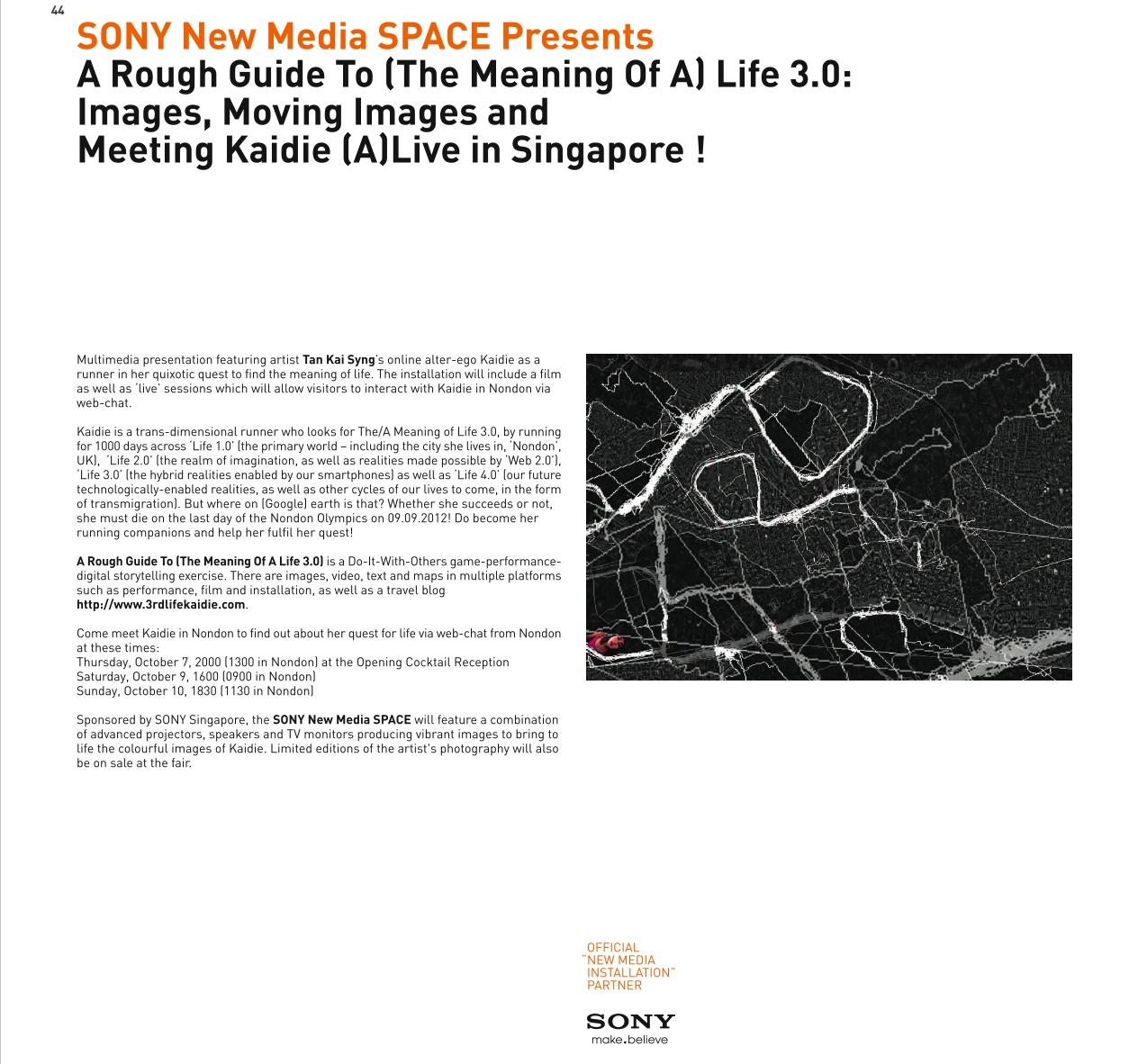 Above: From the ARTSingapore catalogue. Below: from I-S magazine, Singapore.
Above: From the ARTSingapore catalogue. Below: from I-S magazine, Singapore.
HITS & MISSES, FITS & KISSES: Let’s agree not to run into each other, but won’t you let us take us for a ride? GAME FOR A COLLABORATION WITH US ON OUR EPIC QUIXOTIC QUEST?
The trans-dimensional runner of this quixotic life has at any one time one foot on the ground, pragmatic/rational/grounded in sturdily hardcore realism, and the other airborne, in cuckoo land and blue skies, with extra-terrestrial visionary eyes on each (swollen) toe, taken with skyscraper-tall mountains of heartattacky salt.
In this Web 2.0 Do-It-With-Others storytelling exercise, we have been privileged to have undertaken several collaborations with you, in our quest for the Meaning of Life 3.0. Here is an other idea for a collaboration (first conceived in early 2010):
As it is, we have not met 99.782 per cent of you, given that our interaction has been only in Life 2.0, ie, via the channels of this running blog, Facebook, Youtube, GPSies, Twitter and so on – and our imagination, of course. Also, given that we are partly an imaginary creation, meeting in real life is possibly an unimaginable task. (That said, we do not think that encounter in one dimension is of lesser or more significance than an other) In this idea of a project, to make the point that we want to maintain or create a critical distance between us, let us go out of our way to deliberately not meet in Life 1.0. The way to go about doing this is that one person shares her routine over a prescribed period of time. The other person – let us call them the/an ‘anti-stalker’ – will journey on the same route, but intentionally missing the previous person, by a few minutes/moments/metres/centimetres.
The thrill/beauty/cruelty/point of the game is to come so very close to have nearly met – but to just stop short of actually encountering the other. Afterwards, the pair could compare their GPS tracks and find out and plot, point by point, by exactly how much they have missed each other. (And of course, this sharing can be done remotely). As a consequence, one or both parties can derive (perverse / poetic) pleasure from the fact that they could theoretically have been in the same time and space, and could have had an encounter, but willfully and precisely do not. The deliberate orchestration of a denial of a run-in is the point of this project. Hence, we will never come face to face and whisper ‘Hi!’, ‘Nice to meet you!’, ‘Nice to meet you again!’, ‘And who are you?’; one may come close enough to catch a whiff of the other, or sneak a peek of the other’s shadow, or catch a dying footprint, but / and that is about it.
The game can be more fun if more participate. An orgy, not of presence, but absence, with participants who are missing – although we will hardly miss one another.
The great thing about this project is that it is of course hardly original, as many of us are already accomplished practitioners in some degree or an other, but, my Dear Conspirators of Pleasure, do you not think that it will be infinitely (more) enjoyable should we make this a studied and planned collaboration/game, with set parameters to play?
So, are you game? (Ah, the wonders of technology, to allow us to indulge, stretch and realise such fantasies…)
** Currently #5 in the War of Films contest: CLAUDIA TOMAZ’S film about KAIDIE AND HER MEANING OF LIFE 3.0. VOTE NOW!** Vote by clicking on + sign at the top of video player. ** Don’t forget to vote for Episode 2, Run Kaidie Run, too!**
KAIDIE PAYS HOMAGE TO SOME OF HER VIRTUAL RUNNING BUDDIES AT HER LIFE 1.0 SHOW! #8 YOU CAN BE KAIDIE’S COLLABORATOR TOO!
These are but a handful of Kaidie’s running buddies – real, virtual, imagined – so far, whom Kaidie has met in her Life 3.0 in the past 7 months. There are many, many more! YOU can play a role in Kaidie’s life/ lives! Kaidie’s is a collaborative, open(-ended?) quest for The Meaning of Life 3.0! RUN with her for the rest of the 790 days! Here are just a handful of outcomes Kaidie has created with YOU, My Dear Reader/Contributer/Collaborator/Conspirator of Pleasure, so far, including by some of these amazing Nondoners photographed here!. Contribute, by writing in, sending her feedback here, giving her suggestions, sending her images and sounds and ideas for her to jam with, with you! Add ‘Kaidie Nondon’ as your best Facebook Friend Forever! Friend ‘Kaidie3rdlife’ on Youtube! Follow Kaidie ‘live’ on Twitter! Track her Life 1.0 tracks on GPSies! Friend ‘Kaidie Absent’ in Second Life! Help us make this the best run of our lives!
JAMES ODLING-SMEE’S GENESIS OF THE CHOCOLATE NEMESIS.
Under ordinary circumstances, Kaidie can demolish any Nemesis – especially Dark Chocolate ones, and in particular those of 70% cocoa and above (yes, ones that are 85% too) – with absolutely no effort. Including, and especially big big big ones. However, under extraordinary circumstances last week, The Chocolate Nemesis (TCM) launched a most brutal attack (Perhaps Kaidie shouldn’t have departed from her Companion For The Evening? Would CFTE have helped her win the Battle?). Kaidie did not expire before her 1000-day grant, being skillfully saved by 2 Amazing Angels. Here, we learn about the genesis of the word famous James Odling-Smee‘s Formidable Chocolate Nemesis. Mister Odling-Smee is one of Kaidie’s virtual runing buddies whom she met when running in Life 2.0, specifically, the evil Facebook. Here is THE FIRST EVER CAKE AND RECIPE SHARED ON A RUNNING BLOG OF A TRANSDIMENSIONAL RUNNER. Yes it is official!
25-30 JUNE: Display of WHY RUN? (WHY NOT?) and other mind+mentalmaps. Slade Centre of Research, Nondon #4
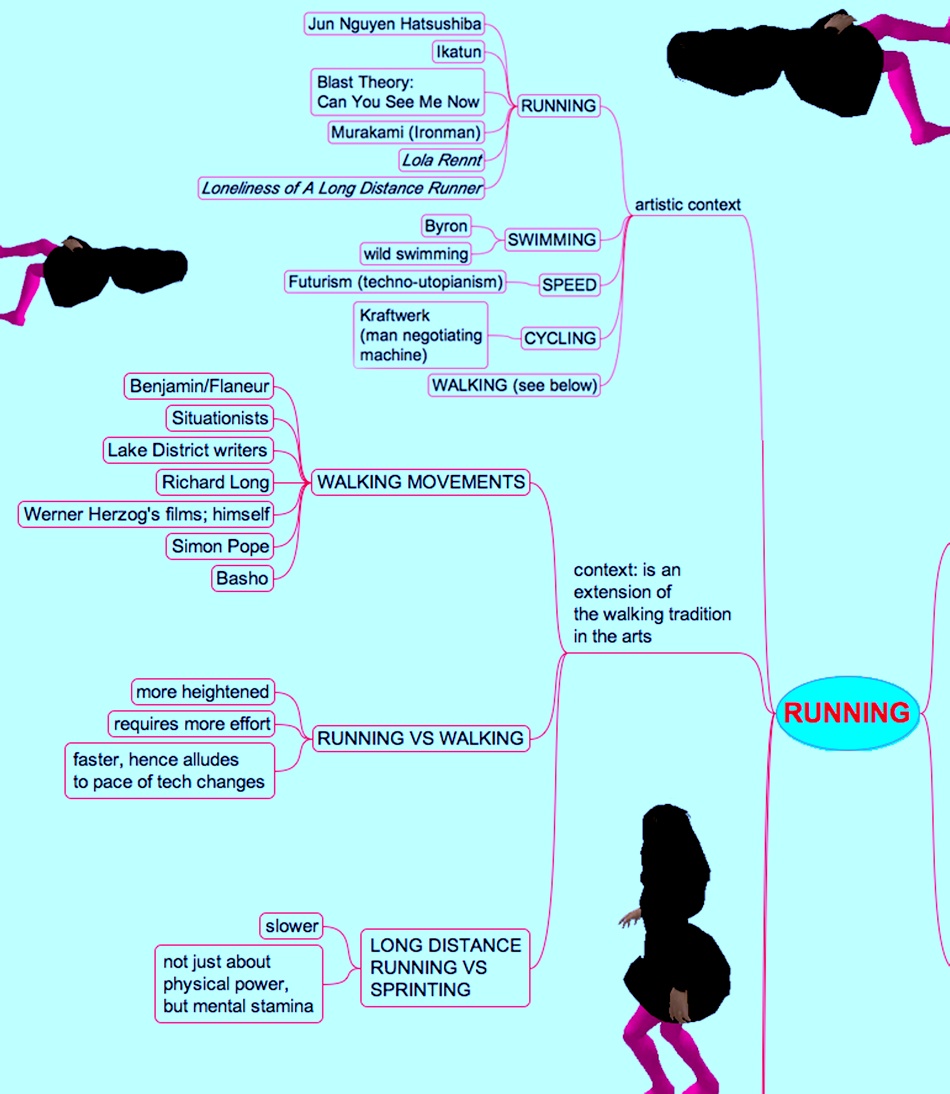
NOTHING COMES FROM NOTHING, AND RUNNING HAS SEVERAL HISTORICAL THREADS.
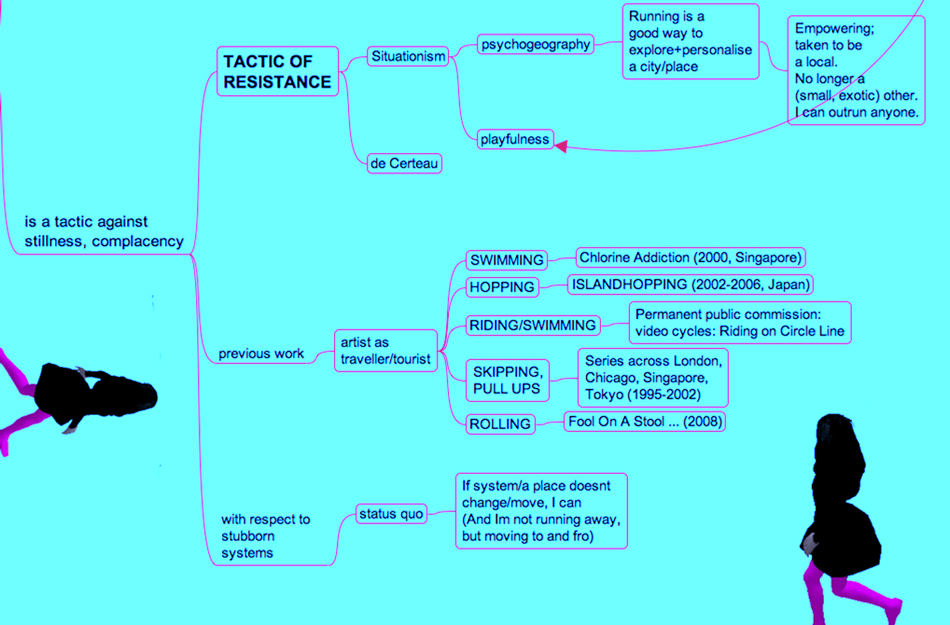
RUNNING AS A SIMPLE, VISCERAL COUNTERPOINT / CRITICAL STRATEGY FOR OUR TECHNOLOGICALLY-MEDIATED REALITY. (PLUS: HULA-HOOPING IN I AM FIT FOR LIFE 2000)
IT’S DAY 152, AND KAIDIE CERTAINLY HAS MUCH CATCHING UP TO DO. In the midst of trying to make sense of Nondon now/here.
Hello world. Again. I’ve run back to run my own lives. For now.
For the benefit of those of you who have just joined me on my quest, here’s a summary of the events in March and April: On 2 March, while running along Fuston Road, I fell head-over-heals. I dislocated a part of my body. Thereafter, I could not be located. I had been kidnapped by The Good Pirate into the world-within-world-within-world of Phuket 2.0 in Second Life. In my absence, a reader, Kailives, hacked into my account and ran my lives on my behalf, by maintaining this blog, my Facebook Twitter and Youtube pages, as well as standing in for a few of my gigs. I did make brief appearances in some of these events, and that was how my whereabouts was uncovered. Finally, on my 5th-month birthday, I decided to break free from my kidnapper, and left the metaverse.For better or for worse, but for a restless runner, it is certainly not for good.
Kailives did try her best to do my job in my absence. However, in this collaborative quest of the meaning of Life 3.0 of Kaidie’s, there were several issues that her co-runners raised that made Kaidie slightly dumbfounded. Some of them are reproduced in the above image. In the coming weeks and months, I will have to try to think about them and respond to them. So, my dear readers and fellow-runners, thank you very much indeed for all your advice and support so far. Please do be patient and give me some time to carefully look at your advice. Kailives has left, but if need be, I may get her back, if I need her voice.
At this point, however, I can respond loud and clear, in absolutely no uncertain terms, that I will have to say no to the suggestion that Kaidie should make a baby in her quest for the meaning of Life 3.0. Kaidie’s response is NO, no, no thank you, never. No. Kaidie will make no baby. Especially not now, given the way things seem to be heading in Nondon.
TRAVELLING IN THE WORLD-WITHIN-WORLD-WITHIN-WORLD OF THE METAVERSE
 The following is an other one of several imaginary discussions between ‘Pro-First-Lifers’ (realists who value meatspace more than our virtual) and ‘Pro-Second-Lifers’ (Cyber-enthusiasts and those who celebrate the power of imagination), in a fictitious online academic forum. Entitled (How) Does Physics Function In Cyberspace? Metaphysical Enquiries For The 21st Century: An Online Peer-To-Peer Peer-Reviewed Forum, subscribers include very serious philosophers, psychologists, media theorists, writers, cyber-geographers, cyber-artists, cyber-anthropologists and cyber-anybody-else. And very, very serious PhD students. However, it is sometimes unclear which side they speak for. It is also suspected that some of the subscribers may have more than one account and speak from different sides. Like the real world, the online world is not black and white …
The following is an other one of several imaginary discussions between ‘Pro-First-Lifers’ (realists who value meatspace more than our virtual) and ‘Pro-Second-Lifers’ (Cyber-enthusiasts and those who celebrate the power of imagination), in a fictitious online academic forum. Entitled (How) Does Physics Function In Cyberspace? Metaphysical Enquiries For The 21st Century: An Online Peer-To-Peer Peer-Reviewed Forum, subscribers include very serious philosophers, psychologists, media theorists, writers, cyber-geographers, cyber-artists, cyber-anthropologists and cyber-anybody-else. And very, very serious PhD students. However, it is sometimes unclear which side they speak for. It is also suspected that some of the subscribers may have more than one account and speak from different sides. Like the real world, the online world is not black and white …
Since March 2, Kaidie has been running about in Second Life as Kaidie Absent, having been kidnapped by The Good Pirate, a.k.a. Chutha Achavasmit, away from Life 1.0. The images we see here are screen grabs from Kaidie’s Cyberspace Odyssey in the past 2 months.
Perhaps it is about time Kaidie runs out of the Metaverse, and come ‘back’ to run her Life 1.0, Life 2.0 and Life 3.0 by herself.
…
Bruce Damer: The surface area of virtual worlds (if an avatar’s height is taken as a unit of measure) will probably exceed the surface area of the Earth within a couple of years.[1]
Pro-Second-Lifer C: Thanks to the Internet, my world has expanded vastly. Cyberspace is a not only a great place to visit – within there, there are so many more worlds that I can inhabit. The attraction of the virtual worlds of MUDs and MMOGs is how nearly anything is possible, including things I cannot do in Life 1.0, and things that once only belonged to the realms of my imagination in Life 2.0. Thus is their attraction, as their popularity attest. China alone recorded 55.5 million online gamers by 2008, with the total market value for virtual transactions at RMB 10-13 billion[2]. What Damer said in late 1997 with respect to Alpha World is not far fetched (although hitherto unverified, to be sure). According to Edward Castronova, tens of thousands of people are logged on into virtual worlds at a time, 24 hours a day, all year round. And, for many, ‘life in the virtual reality spaces seemed preferable to life on Earth.’[3]
Wagner James Au: On an innovation scale, Second Life suggested the potential for MMOs to also be a development platform for commercial, educational, and research projects. […] In South Korea, an estimated one in twelve members of the entire population have played an MMO called Lineage; in China, a whole cottage industry is devoted to “gold harvesting”, the acquisition of gold coins and other fictional money in MMOs. […] As broadband and high end PCs saturate the international market, it’s time to consider MMOs as the likeliest candidate for the Internet’s next generation, supplanting the two dimensional, semi–interactive portal of the Web for an immersive, three–dimensional, fully interactive Metaverse of data. [4]
Pro-First-Lifer C: I am baffled about these statistics of the happenings in Life 2.0, since I can hardly feel a thing in Life 1.0! What is shocking is how pervasive, in all aspects of Life 1.0, this impact has been! What is even more disastrous to contemplate, is Au’s mad prediction is that this mad fictive world within the already-mad Internet world will become the norm of the Internet! What on earth are the conditions that are behind this exodus, where you, and all the millions of gamers ‘leave the real world behind’[5]?
Edward Castronova: [… ]the industries that produce shared virtual reality environments [are developing] rapidly. Advances in connectivity (bandwidth) and interfaces (haptic devices, heads-up displays) have been driven by technology. The amount of available content (narratives, folklores, backstories) has expanded; the video game industry has begun to surpass the motion picture industry in gross revenues. As the phenomenon continues to grow, the aggregate amount of time devoted to shared virtual reality spaces seems likely to rise from today’s tens of thousands of person-years into the hundreds of thousands or perhaps millions.[6]
Pro-Second-Lifer C: There are no lack of examples of large corporations expanding into Cyberspace and building virtual worlds, such as Sony and Microsoft, and Electronic Arts, which support Sims. [7]
Edward Castronova: The Earth is very nice, but there are experiences we can imagine in our minds that we cannot have here. [8]
Pro-Second-Lifer C: Preferring the term ‘synthetic world’, Castronova defines one as ‘persistent online 3D spaces that replicate many of the features of the real world’. Similar to a video game character, the user negotiates synthetic worlds using a virtual body, known as an avatar. That thousands of people can be in the world at the same time make the environments ‘much like a real place, socially speaking’. The worlds, according to Castronova, ‘have a sort of fantastical yet logical reality to them, such that people can fly, but only if they have wings or a flying spell or happen to be birds to begin with.’[9]
William Gibson: A square of cyberspace directly in front of him flipped sickeningly and he found himself in a pale blue graphic that seemed to represent a very spacious apartment, low shapes of furniture sketched in hair-fine lines of blue neon. A woman stood in front of him, a sort of glowing cartoon squiggle of a woman, the face a brown smudge. “I’m Slide,” the figure said, hands on its hips…[10]
Pro-First-Lifer C: Do you not see the problem? These are much like, as Castronova says, but are definitely not real places. You are looking through what Tim Guest labels an electronic looking glass[11], and everything is distorted! You are going the dark streets, the downward spirals, where you would not have dare even thought of venturing in RL.
Pro-Second-Lifer C: What might the problem be? Take pornography – being highly stylised with its own sets of conventions, no one takes them to be ‘the real thing’, but simulations and performances. No pun intended, but pornography slips in and out of ‘reality’ as we know in Life 1.0, to the extent that it does not even matter if they are real or not. This would be the fictive world that philosopher Daniel Dennett says we do not question in this way, because it is not set out to be approached as such.[12] Reality is not the question. Whether something is real or not, or, for that matter, if it is distortion or not, is not the point. This is no different from your illicit agreement with the rules of cinema, when you enter a movie theatre. While you are in there, within the magic circle, you suspend your disbelief, and for the next 90 minutes watch a similar-looking, albeit also significantly different, world unfold in front of you. And it’s even better in a virtual world, since you can participate in it, and direct it!
Sherry Turkle: MUD players are MUD authors, the creators as well as consumers of media content. In this, participating in a MUD has much in common with scriptwriting, performance art, street theater, improvisational theater, or even commedia dell’arte[13].
Wagner James Au: Unlike most MMOs, Second Life encourages its subscribers (the preferred terms is ‘Residents’) to literally build the world with the construction and programming tools provided for them.[14]
Edward Castronova: A not insignificant fraction of the players of these games reported that they felt themselves to be not game players, but citizens of a new world.[15]
Pro-Second-Lifer C: From a wild, untamed piece of virtual land, entire mansions, towns and cities and be architected, hence increasing my sense of ownership and belonging in these worlds. Like Hiro, I can imprint my virtual addresses on my namecard. With a place to call home, and one I have built (or paid Linden dollars for someone else to build) at that, who wouldn’t want to keep going back back?
Pro-Second-Lifer D: Following Pro-Second-Lifer C’s previous line of thought, Cyberporn is even more attractive than porn, being a simulation-within-simulation, a double-simulation. Similarly, a virtual world, being a world within the world of cyberspace, is a double attraction. Virtual worlds are even better than pornography, since I am not only watching it, but participating in it! Well, very nearly. (Sex within virtual worlds is a topic that warrants long discussions – let us do that in a separate thread.) Hard-core Second-Lifers, such as the Second Life resident journalist Au, even go to the extent of describing cyber-activities outside of virtual worlds, such as emailing and blogging, as belonging to ‘real life’![16]
Wagner James Au: […] the experience of one’s alter ego being in an immersive space is experientially different from any other kind of Net–mediated interface that has come before it. Different, and in several key ways, better, than the limited, distanced, largely asynchronous interactivity of the Web as it exists now. An MMO quite literally offers a direct pathway into data, and global collaboration with an international community through avatars that afford each individual a high degree of anonymity, and paradoxically, an equally high degree of self–representation. With so much potential, and the technical/commercial infrastructure in place to make it feasible, it’s difficult to imagine online worlds not becoming the next real leap in the Internet’s evolution. [17]
Pro-Second-Lifer-D: Au is referring to immersion, that which distinguishes being embedded in a virtual world from other kinds of net-mediated interfaces. There are 2 types of immersions that Computer Mediated Communications (CMC) researchers have identified: ‘perceptual immersion’ and ‘psychological immersion’ (the latter drawing us back to the how we derive pleasure from pornography, the art of simulated pleasure – it is all in the mind). Hard at work as well here is the concept of flow.
Richard Bartle: Virtual world designers view psychological immersion as paramount, considering perceptual immersion to be merely one of many possible means to achieve that end. Immersion is also connected with the psychological concept of flow. […] Flow is an exhilarating sense of control and mastery that can arise from pursuing a focused, goal-driven activity; it’s a deep involvement that transcends distractions and sense of time, leading to an ecstatic state of peak productivity.[18]
Pro-First-Lifer-D: Call a rose by any name – flow and immersion are just fancy ways of saying the old, familiar dirty word: addiction.
Sherry Turkle: Stewart is logged on to one MUD or another for at least 40 hours a week. It seems misleading to call what he does there playing. He spends his time constructing a life that is more expansive than the one he lives in physical reality.[19]
Pro-Second-Lifer C: I do not mean to sound pedantic, but addiction has a physical component alongside the psychological one. The concept of flow, theorised by Mihaly Csikszentmihalyi is a positive and creative one, which refers to the ‘optimal state of experience for the individual is one in which intentions are not in conflict with each other’. [20] This is the state of heightened energy and focus where one could lose track of time. This altered state of consciousness is the same state experienced by a runner on a runner’s high, a person taking drugs or an artist at the peak of creativity.[21] And, if you wish to talk about an old, familiar dirty word, the word, my friend, is not ‘addiction’ but ‘TV’. Dr. Turkle certainly does not think of being in-world as automatically a bad thing.
Sherry Turkle: If the computer is replacing time with peers and parents, that’s not good. But if the computer is replacing television, then that may well be an upgrade.[22]
Pro-First-Lifer D: But Dr Turkle, you do not realise that the computer is the new TV! In 1895, the audience ran away at the sight of the approaching train in the Lumiere Brothers’ projection. And although the premise of Orson Welles’s radio prank was obviously improbable (invasion of aliens – or, for that matter, pancakes), listeners were sent into a panic. TV entered our living rooms and became our windows to the world; now the entire earth is brought to you on your laptop. We were enchanted then by the capability of these shrewd mimetic machines; today, we are still at the stage of enchantment by the Internet and its dark streets. Even better than photography and cinema, we are now able to not only mimic reality, but be more real than real. We need to unpack this simulacra, and like Barthes, track down, in the ‘decorative display of what-goes-without-saying’, the ‘ideological abuse’ hidden there[23] Break the fourth wall, step out of the magic circle and wake up from the evil dream!
Pro-Second-Lifer D: It is clear that not being of this (virtual) world, you cannot understand what we have said about the rules of the game, the ‘laws of nature’ in-world, if you like. Or, you are one of the spoilsports, what we term ‘griefers’ in-world.
Wagner James Au: Griefing is at heart an attempt to violate the implicit social contract needed to sufficiently maintain the consensus reality necessary for an online world to function. By looking for flaws in that implicit agreement, griefers often force the company and the community to examine basic assumptions in its structure — something potentially valuable in itself. […] [But, more] fundamentally, their behavior breaks the world itself, in a way that’s inexplicable from within the context of a world. Again, a shattering of the consensual reality not intended by the owners or the inhabitants, often through external, artificial means. [24]
Pro-First-Lifer D: ‘Consensual reality’? Mr Au, you have been in-world for so long that you are unable to spell properly. ‘Consensual unreality’, more like! How deluded are you! Are you all cultists, dimwits in denial, or simply mad? Or are you all failures of the real world, and hence escape and create alternative realities? Are you all blind wo/men with the elephant, and in Plato’s cave, or rather, Dungeon, as it were?! Nearly half of your lot – 43% – actually believe that what you do in-world is as important as RL, according to a new study. Unbelievable![25]
Pro-Second-Lifer D: What you said about artifice is extremely rich coming from your world as well – so many of your so-called rules are artificial constructs as well. Pick any – gender, sexuality, race, the list goes on. Surely we do not have to go into all that discussion again, for we have moved on. That is why we are here, in-world. And contrary to what you say, we are very much ‘awake’ and sober here, as everyone comes in knowing well that this is an artificial, constructed world, the ultimate Brechtian truth. I also argue that this is a more deliberate life, one that you enter willingly, than the one you are simply thrown into. Hence it is a life of a higher quality than Life 1.0, because you have come in of your own will, and you construct yourself as you like, and live as you wish.
Pro-Second-Lifer C: Pro-First-Lifer D, once again, recall what we said earlier about how much the real world is realising the importance of our Second Lives, by joining in. Au rightly points out the importance of positioning online worlds as a part of the real, echoing Dr Turkle’s reminder for us to take them as more than just games, but to pay attention to what they reveal about us[26]. The director of the USC Annenberg School Centre for the Digital Future, Jeffrey I. Cole, also remind us to pay attention to the Internet as a powerful medium.
Wagner James Au:[ …] [I]t’s time to approach these worlds with the seriousness they deserve — to treat online worlds as an essential, inseparable part of our contemporary experience.[27]
Sherry Turkle: Some are tempted to think of life in cyberspace as insignificant, as escape or meaningless diversion. It is not. Our experiences there are serious play. [28]
Jeffrey I Cole: More than a decade after the portals of the worldwide web opened to the public, we are now witnessing the true emergence of the internet as the powerful personal and social phenomenon we knew it would become The internet has been a source of entertainment, information, and communication since the web became available to the American public in 1994. However, we are now beginning to measure real growth and discover new directions for the Internet as a comprehensive tool that Americans are using to touch the world. [29]
Pro-Second-Lifer D: I shiver at bit at Cole’s last statement though – is he implying an American online invasion?!
Pro-Second-Lifer C: Let’s just ignore his bragging. Pro-First-Lifer D, I have yet more examples of interesting First Life presence in Second Life, which reminds us of the point raised by Dr Dodge about how ideology comes into play in cybergeography. In 2007, news website Islam Online created a virtual Mecca in SL, and in the first Hajj, 7,000 people ‘made the journey without even moving’. Not only does this help to provide some relief to the some annual congestion of two million pilgrims, Island developer Walid Wahba says that this aids to ‘educate both Muslims and non-Muslims about the journey. It shows people what the Hajj is and what we do when we’re there.’[30] And, in somewhat amusingly light parlance, he continues: ‘They can check out the worship of God.’[31]However, as common in RL, conflict and discrimination abound in SL. In this case, griefers plastered up pornography on the building, shouting: “We will not leave this place unless this island is shut and Muslims are out.” [32] In 2006, an Israeli built the first synagogue in SL, which grew into a full Jewish neighbourhood with more than 600 members[33]. This expanded into an Israel Island in the following year. Today, users can visit the Old City, Western Wall, the Church of the Holy Sepulcher and the Dome of the Rock, or ‘float’ in the Dead Sea [34] – sans humiliating manhandling by the ill-mannered Mossads for no less than 5 times during immigration checkpoints. One cannot help but attempt to draw parallels about the Israel’s contemporary presence and expansion online, with its troubled endeavours offline, today and historically. Indeed, when interviewed in 2007, the creator of Israel Island had remarked – in hindsight or with foresight, or perhaps innocently – that ‘Second Life is a combination of the real and the imaginary. This came true in December 2008: when Israel launched its brutal attack on Gaza, people, offline and on, reacted furiously. Au reports first hand, in-world.
Wagner James Au: As the airstrikes pounded Gaza, so did protesters, teleporting into SL Israel, waving flags.[…] [T]he protesters kept coming, and eventually [the creator] felt forced to close all of SL Israel to outsiders.[35]
Pro-Second-Lifer D: To continue with Pro-Second-Lifer C’s point about geopolitics: The government of Singapore, the tiny nation with more than 100% broadband penetration, has even bought land in SL. Given that the island has reached her geopolitical (land reclamation) and safety (aerial) limits for expansion, virtual expansion provides the next best ego boost. The young country may also try to lure new (virtual) immigrants from SL, which boasts a population more than double that of Singapore.[36]
Pro-First-Lifer D: You have presented some stark information here. But I am not convinced that SL and the likes are filled with decadent hairy hippie idealists – that is the foundation after all, is it not? Second Life itself says that it is an attempt at a realization of Stephenson’s Metaverse[37]. Also, Au himself states that ‘[m]uch of the Internet’s development in the ’90s was fueled by the cyberpunk–tinged, Bay Area techno–utopianism of Wired.’[38]
Pro-Second-Lifer C: I have to admit defeat with regards to your point about hippies. They have shaved, put on clothes, tuned in and wired up too. I have to admit that we do have them here. One just can’t shake them off, even in SL… Actually I may even be one of them, but you may never find out. Anyways, do not let a few cultural glitches turn you off. Just like RL, SL has a large diversity of people, and non-people. Just like RL as well, SL has different landscapes and sceneries for every taste and experiment. You could have sex with a horse[39], take part in an anti-Bush protest[40] or become an octopus and rape another octopus, or more radically for an octopus, have sex with, or rape a human being[41]. Au himself boasts of the myriad of pixelated beings that he has interviewed,
Wagner James Au: I’ve interviewed strippers and Catholic priests, combat veterans and peace activists, socialist utopians and midget warmongers. I’ve profiled entrepreneurs who own whole continents and earn six figure incomes from the buying and selling of virtual land, and a homeless hacker who built a virtual mansion while squatting in an abandoned building. [… ]I am talking about seeing the citizens of online worlds as a cross–section of the world itself. […[ And even though none of these events or persons really exist, except as data bits in a San Francisco server farm, they’re part of the best story I’ve ever been lucky enough to cover as a journalist. Because I’ve come to believe that it’s an inadvertent advance report on the future of the Internet, and how we’ll interact in it in decades to come. [42]
Pro-First-Lifer D: You need a reality check. In fact, I am going to leave this forum right now and return to Life 1.0. Get a Life 1.0, you.
Moderator: Discussion closed.
This was sketched in January 2010. Obviously, some things, including Kaidie’s grasp of things and her own position, have moved on. We are just uncertain if the ‘moving on’ is a progression, regression, or an other loopy trip).
[1] Bruce Damer, author of Avatars! Exploring and Building Virtual Worlds on the Internet in late 1997, quoted in ‘To Thine Own Selves Be True: Review of Sherry Turkle’s Life on the Screen’, Introduction to Computers and Technology: Electronic Resources Center [accessed 25 December 2009].
[2] ‘JLM Pacific Epoch – CNNIC: China Has 55.5M Online Gamers’, JLM Pacific Epoch, 2009 [accessed 5 January 2010].
[3] Edward Castronova, ‘Theory of the Avatar’, SSRN eLibrary, 2003 [accessed 4 January 2010].
[4] Au, Taking New World Notes. [accessed 30 December 2009]
[5] Tim Guest, Second Lives, Arrow Books, 2007, p. 9.
[6] Castronova, ‘Theory of the Avatar’.
[7] Castronova, ‘Theory of the Avatar’.
[8] 2005, p. 25, quoted in Freund.
[9] Edward Castronova, Synthetic Worlds: The Business and Culture of Online Games (University Of Chicago Press, 2006), p. 1.
[10] William Gibson, ‘Count Zero’, Voidspace, 1986 [accessed 5 January 2010].
[11] Guest, p. 1.
[12] Daniel Dennett, ‘The Self as a Center of Narrative Gravity’, in Self and Consciousness, ed. by F. Kessel and D. Johnson (Hillsdale, NJ: Erlbaum, 1986), pp. 275-88 [accessed 5 January 2010].
[13] Turkle, ‘Who Am We?’ [accessed 30 December 2009]
[14] Au, ‘Taking New World Notes’.
[15] Castronova, Theory of the Avatar.
[16] Au.
[17] Au.
[18] Quoted in Michael Hohl, ‘A Glossary for Interactive Technologies’, Hohlwelt, 2009 [accessed 5 January 2010].
[19] Turkle.
[20] Quoted in Hohl.
[21] Mihaly Csikszentmihalyi, ‘Flow’, TED talks, 2004 [accessed 22 November 2009].
[22] Technology Review, ‘Life On Line – S. Turkle Interview’, Pol.it: The Italian on line psychiatric magazine, 1996 [accessed 22 December 2009].
[23] Roland Barthes, Mythologies, Later Printing (Farrar, Straus and Giroux, 1972).
[24] Au.
[25] ElectricNews.net, ‘Second Life equal with First Life •’, The Register, 2006 [accessed 5 January 2010].
[26] Turkle, ‘Who Am We’.
[27] Au.
[28] Turkle, ‘Who Am We’.
[29] ElectricNews.net.
[30] ‘Second Life Visit To Mecca For The Hajj’, Sky News: Technology, 2007 [accessed 22 December 2009].
[31] ‘Second Life Visit To Mecca For The Hajj’. Italics mine.
[32] ‘Second Life Visit To Mecca For The Hajj’.
[33] Megan Jacobs, ‘Second life Israel | Internet and Technology | Jerusalem Post’, Jerusalem Post, 2008 [accessed 22 December 2009].
[34] Jacobs.
[35] Wagner James Au, ‘New World Notes: Disputed Territory: War in Gaza Provokes Protest (And Conversation) In Second Life Israel’, 2009 [accessed 22 December 2009].
[36] Nicholas Aaron Khoo, ‘Come to Singapore in your Second Life! – CNET Asia Blogs: Geekonomics’, CNET Asia, 2007 [accessed 5 January 2010].
[37] Au, Taking New World Notes.
[38] Au, Taking New World Notes.
[39] Xah Lee, ‘Animal Love in Second Life’, A Tour In Second Life, 2007 [accessed 29 December 2009].
[40] Au, Taking New World Notes.
[41] Xah Lee, ‘Forced Play in Second Life’, A Tour In Second Life, 2007 [accessed 29 December 2009].
[42] Au, Taking New World Notes.
ON 19 APRIL, KAIDIE ABSENT AND HER KIDNAPPER, CHUTHA INDIGO, HAD A VISITOR, MONO FUGUE, IN PHUKET 2.0.
Since March 2, Kaidie has been running about in Second Life as Kaidie Absent, having been kidnapped by The Good Pirate, a.k.a. Chutha Indigo, away from Life 1.0. On 19 April 2010, they had a visitor Mono Fugue a.k.a. Monologues, in Virtual Phuket, which is built by Chutha Indigo. And what fertile ground for getting disoriented: Phuket, a beach resort in Thailand vs. Phuket 2.0; Gavle, Sweden vs. Nondon, UK; GMT 14:30-19:30 vs. GMT+1 in Sweden vs. SLT 06:30-11:30; experience vs. imagination; memory of actual visit to Phuket 1.0 vs. (re)visit of Phuket 2.0; online vs. being disconnected; immersion vs. distance; tropical sunset vs. still-frigid Gavle; catching a bus in Life 1.0 vs. flying, gravity-free, in Life 2.0; panting in RL vs. coffee-sipping in SL. The following is a reflection written by Mono on his experience.
Nausea (or how I learned to love getting lost and finding myself in a pattern again)
Fourteen years ago I had my first encounter with a high speed internet connection. People in my surrounding rarely used internet and barely had any meaningful use of computers. Five megabytes was a very big file and digital camera photos were stored on 1.44 Mb floppy disks. At this time I was determined to become a future space cowboy, found rocket science a dream but language studies a hell. Little did I know that my perception of this would shortly flip and pretty much lay out a road that I’ve been following ever since.
Text-based chat room, from which I was wired to the world extended my known borders from the small village I was living in to some form of metaphysical realm I could only see but not touch. Yet, like an addict my hunger grew for this super-speeded (back then) information overload, and oh what a fascination that was! Just the knowledge I was sharing the same space with an interesting girl from Tasmania to a shaman somewhere in the U.S. blew my mind. In contrast my village shrunk and I pretty much lost any interest in what it had to offer.
One day I heard of an online project, or yet more, like a community in a virtual world, called Alphaworld caught my attention in an instant. It offered a graphical landscape in which you could move around, build houses and interact with the other habitants (sounds familiar?). Now, my school back then disallowed the students to install any programs (as alpaworld required) and to tell you the truth, computer power was not exactly magnificent back then. I didn’t even own a computer back in 1996, and when I later got one it had a 16 greyscale screen, began coding websites in black and white and doing Photoshop work in.. eh.. greyscale. So what happened with Alphaworld then? The closest I got was connecting to this promised land with a 28.8K dial-up modem from my friends house (in the same village) who’s parents just spend one months salary on getting the latest 66 MHz PC. Alphaworld turned very distant as my presence in this virtual world was limited to a 1 frame per minute refresh rate. My only memory from this world became a printed map, a Mondrian-type pattern which completely drenched the paper with bubble-jet ink.
Fourteen years, some hundred hardcoded websites, programming and complex video editing skills, two new languages, a college degree and thousands of hours in front of flickering screens and a lifetime later I’m sitting on a bus to the same village. In my lap I have enough computer power to make Sputnik literally a blip in space, radiated by 16.8 million colors in my face and a mobile broadband connection through an iPhone I have never ever been as wired as I was that day. Despite the fact that I’m in eternal love with landscapes speeding by, have a fetish for airplane take-offs and living with a constant urge to get geographically lost there are moments I rather just make my trip from a to b in an instant. This day I would however spend my time in a different way, being invited to a meeting in Second Life seemed a rather pleasing experience and a way to make my journey a bit closer to that sensation of instant teleportation. Taking into account I had no greater interest in what this virtual community had to offer I was still surprised of the resemblance to my nostalgic Alphaworld. Except, this time I was physically moving my body, yet largely unaware of what was actually going on around me. My eyes and ears were wired to another space. While I was traveling down the highway between two Swedish cities I was mentally visiting the Thai island of Phuket. Emotions were sparked as I recognized places I have physically been in or had some sort of memories connected to it. While hovering above the virtual soil of Phuket in spherical photo realistic representations, jumping from one gallery to another, one virtual space to antother, while sipping from my virtual coffee cup, the bus driver drove me some 25 kilometers. The time-space continuum seemed to have broken apart as it only exists as a hiatus in my mind. Instead, my physical bus-ride in Sweden now only carries the memory of a visit to Phuket with a pleasant coffee/gallery/chat-session with Kaidie Absent and Chutha Indigo.
Projecting myself to Second Life while letting my body stay in First Life was however not a painless experience. Having the sensation of a nearly related astral projection; traveling without moving (or in reverse) triggered a weird kind of nausea… being there, but being here, but being there. I was not entirely physically disconnected, yet completely wired, and absolutely mentally in another space, floating in a liminal realm of inbetween-ness. At some point I thought to myself, is this how it feels to be born into a new world, you panic at first, have no idea what it is that you see nor how far away the walls or borders of the world are… and slowly vectorized graphics build up a world around you and you get a sensation of a relation to it, which is a slow progress in itself getting acquainted with what there is. The difference here, getting born for the second time, is that the prerequisites for living a second life, in one way or another, forces you to abandon the life you came from. A moment later you switch back and ask yourself, where does my first life end and where does my second life continue? Where do I start, where do I begin in my journey 3.0?
Guest post by Michael Larsson. Michael Larsson is a visual composer who experiments with photography, video, motion graphics or any other (non) electronic method to manipulate light and visuals. Michael’s presence in Life 2.0 can be found on his Website, as well as his Twitter and Vimeo pages. The image on top is created by Michael, while the images below have been captured by The Good Pirate, a.k.a. urban planner Chuthatip Achavasmit.
WHERE IS THAT ‘SPACE’ IN CYBERSPACE? (HOW) DOES PHYSICS FUNCTION IN CYBERSPACE? Where did we come from? Where are we now? Where (the hell) are we off to?
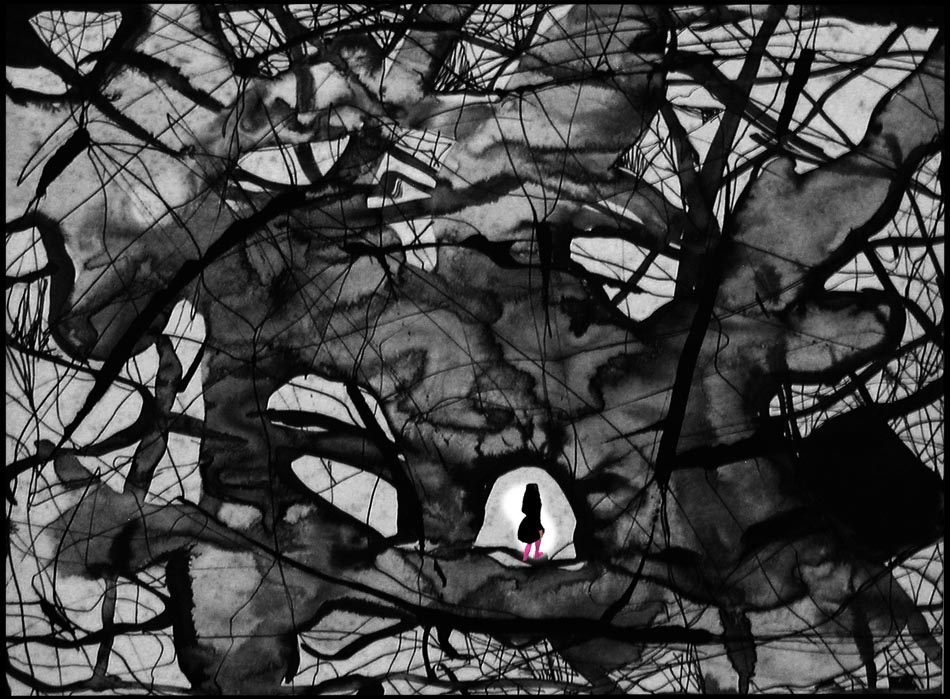
Should Kaidie use this map to plot her escape from her kidnapper in Second Life? After all it's been nearly 2 months since she's been there!
The following is one of several imaginary discussions between ‘Pro-First-Lifers’ (realists who value meatspace more than our virtual) and ‘Pro-Second-Lifers’ (cyber-enthusiasts and those who celebrate the power of imagination), in a fictitious online academic forum. Entitled (How) Does Physics Function In Cyberspace? Metaphysical Enquiries For The 21st Century: An Online Peer-To-Peer Peer-Reviewed Forum, subscribers include very serious philosophers, psychologists, media theorists, writers, cyber-geographers, cyber-artists, cyber-anthropologists and cyber-anybody-else. As in real life forums, participants are civilised – most of the time. Subscribers who identify themselves as a Pro-First-Lifer see Life 1.0 as the more important life, warn us of the dangers that lurk in Cyberspace, and view the Pro-Second Lifers as delusional dreamers who run away from problems they have in RL. Some of them also pelt names like ‘Stelarc Nutters’ and ‘Technogeeks’ at them. On the other hand, the pro-Second-Lifers retaliate by calling them names such as ‘Luddite’, ‘Academics who-are-pretend-Liberalists-but-are-actually-Fascists-in-real-life-Who-Diss-Everything-Because-It-Is-Uncool-Not-To’, ‘Conservatives’ and ‘Amish’. While many subscribers chose to hide behind generic avatars, some bravely use their real names (such as Sherry Turkle, Lev Manovich and Martin Heiddeger). That said, it is sometimes unclear which side they speak for. It is also suspected that some of the subscribers may have more than one account and speak from different sides. Such is the nature of any debates, especially online ones…
Let us begin our Cyberspace Odyssey.
Neal Stephenson: Like any place in Reality, the Street is subject to development. Developers can build their own small streets feeding off of the main one. They can build buildings, parks, signs, as well as things that do not exist in Reality, such as vast hovering overhead light shows and special neighbourhoods where the rules of three-dimensional spacetime are ignored.[1]
Pro-Second-Lifer A: This is an extraordinary time to be alive. Not only can I travel to different cities in real life (RL), there are even more travels I can have outside of RL. Thanks to the Internet, my world has expanded vastly. Cyberspace is a not only a great place to visit – within there, there are so many more places to enter. In Stephenson’s imagination, a metaverse is a ‘place’, with ‘streets’. In Gibson’s, it is a big neon ‘city’, within which there are many centres to visit. But the land size of Second Life alone, at 1,700 virtual square km, is larger than metropolitan London.[2] So it would not be a stretch, even, to describe Cyberspace as a world, within which there are yet many worlds to explore.
William Gibson: People jacked in so they could hustle. Put the trodes on and they were out there, all the data in the world stacked up like one big neon city, so you could cruise around and have a kind of grip of it, visually anyway, because if you didn’t, it was too complicated, trying to find your way to a particular piece of data you needed.[3]
Neal Stephenson: Hiro is approaching the Street. It is the Broadway, the Champs Elysees of the Metaverse. It is the brilliantly lit boulevard that can be seen, miniaturized and backward, reflected in the lenses of his goggles. It does not really exist. But right now, millions of people are walking up and down it.[4]
Pro-Second-Lifer B: Even when simply cruising around as Gibson does, surfing in cyberspace can be akin to psychogeographical tactic that the Situationists advocated in the streets. In these trips, surprises happen, bringing me to unexpected places. When I open my customised homepage on my Firefox browser, I may see a CNN news headlines that I click into to read; there, I may see comments written in by a viewer. Intrigued by her words, I check out her linked Blogspot blog. There, a Google ad pops up to tell me to check out a related topic, which I do, and at the same time, watch a Youtube posting by the same writer, at the same time! I write in a comment to her video, and seconds before I know it, someone else has already responded to my comment. So, another thing that makes my around-the-(Cyber)world-trip better than a RL one, is its simultaneity and real-time quality. It is as if I am visiting London, New York, Shanghai and Johannesburg at the same time! Better still, this world seems to be infinite, with no limits, capable of unending expansion. Like Columbus discovering virgin territories in the 15th century, Web 2.0 is our golden age of exploration, of Cyberspace. As not only a user but a content-creator myself with the easy-to-use tools, not only can I participate in the various virtual worlds, I can construct my own new territories.
Pro First-Lifer A: I might not have the guts to say this to you face–to-face, but I think you are being naïve, crass and Romantic. You are speaking of Cyberspace as if you are Alice entering Wonderland the first time, still in the state of enchantment. In the past two decades, the academic world has been up to speed with this – if not entire new departments like Informatics, there are new divisions in every discipline, such as digital anthropology or ethnography in the ‘old’ discipline of Anthropology, ‘new’ media art in Fine Art (which is by now rather old, so old that artists have dropped the ‘new’ out of embarrassment). This may disappoint you, but there is even the new discipline of Cybergeography – where geographers attempt to fully map the space that you describe as ‘infinite’. The same way psychoanalysts in Life 1.0 rationalise your dreams in your Life 2.0, Cybergeographers conduct their field work online, in-world, and share their data with us in Life 1.0. I am very sorry, but it is time to wake up from your (wet) dreams and have a reality check.
Martin Dodge and Rob Kitchin: The hype around much of Internet, especially in the mid 1990s, was that it was ‘everywhere and nowhere’ and it would make geography less significant in human organisation through the ‘death of distance’. This is patently not been the case. While the Internet has undoubtedly had an affect on the geography of business operation and individual consumption, distance is not dead. What is being witnessed is a complicated restructuring, through processes of concentration and decentralisation, across scales.[5]
Pro-Second-Lifer B: I do not disagree with Dr Dodge and Dr Kitchin. As we invent and use it, we also struggle to make sense of the complex medium. Just as we can approach life itself from different perspectives such as biology, religion and the arts, so, too, could Cyberspace be analysed from various ways. In fact, the penetration of the Internet on our lives is so far and deep, that it is as complex as life itself. And as Pro-First-Lifer 1 pointed out, pre-internet phenomena, disciplines and objects create neologisms, insert hyphens to join the new wave (e-commerce, iphone, Government 2.0); all offices, schools, libraries and institutions in First Life have an equal or even bigger Second Lives online (BBC’s iPlayer, tiny country Maldives as the first country to open its official embassy in Second Life in 2007[6]). Many brick-and-mortar businesses have also found it more efficient to have only virtual offices. So this is a complex stage of re-structuring and paradigm shifts indeed, as First Life attempts to be up to speed with the Second in Cyberspace, in order to fully make use of the powerful medium of the Internet.
Pro-First Lifer A: Check out my government’s website- on the page entitled ‘Social Media and Web 2.0 in Government’, the White House even has a tagline of ‘Better websites, better government’[7]! Recall too how part of Obama’s success during the election was because of his team’s ability to exploit the medium, being pervasive on Youtube and Twitter. So this is a case in point of an clever integration of our First and Second Lives.
Pro-Second –Lifer A: I’m confused though – should it not be the other way around? Better government, therefore better websites? … Anyways, let’s not digress from the discussion of the geography of Cyberspace that Dr Dodge and Dr Kitchin are trying to explain. In any case, no offence to Pro-First Lifer 1, but we certainly don’t need more of this country’s presence in our Second Lives, or of this country’s ‘exploitation’ of anything, for that matter, which we have in our First Lives. Way more than enough. Do not get me started.
Martin Dodge and Rob Kitchin: The idea of the Internet as being somehow ‘anti-geographical’ is based on three key notions: fantasy, denial, and ignorance: 1. Internet geography was assumed not to exist. This is anti-corporeal, cyber-utopianist fantasy that somehow the virtual communities of cyberspace can be produced in a realm divorced from material existence. 2. Internet geography was assumed not to be important, so could be denied. The failure of many e-commerce ventures in the dotcom boom, we would argue, was based in part on ignoring the grounded, geographic, realities of computer-mediated communication, logistic networks and labour markets. 3. Internet geography was assumed not be measurable. Because it was hard to do, it was ignored, especially in the heady days of bubble growth. The medium of communication might be virtual, but the Internet is dependent on physical infrastructure and human labour, most of which is invisible to users. The computers are small in scale and are usually hidden from view in anonymous servers rooms and secure, windowless buildings, while the cables are under floors, in ceilings and in conduits buried under roads. The banal technicalities of Internet infrastructures are easily overlooked (just like for other essential utilities of water, electricity) but they are not naturally given. The geographical structure and operation of networks that service modern living have politics.[8]
Pro-Second Lifer B: Dr Dodge, could you give an example please about the political nature of geography?
Martin Dodge: Domain names are important locational tools at a technical level, but also have a wider political geography in terms of how they are allocated and how this naming relates back to real-world territorial and jurisdictional boundaries. (For example, the recent ruling from a French court that the Yahoo Internet service must block users in France from buying Nazi memorabilia through the web.[9]
Pro-First-Lifer A: Just as there is geopolitics in the real world, there is cybergeopolitics as well. Let us discuss this in a later thread. Pro-Second Lifer 1, your Cyberbubble may burst if you come to my country and see Second Life’s 700 Debian Linux servers in a San Francisco data warehouse[10] – large, physical metals with lots of cables, all working furiously to generate your fantasy world. Just because you do not see them, you are blind also to their presence. And, by the way, if you do not already know, but this is a democratic society, so I have the right to free speech. Or, do you come from a repressed country with dismal human rights records? Have they blocked your Google search engine from the words ‘democracy’ and ‘freedom’ like the Chinese, or even ‘Life’ itself? Or, are you an oppressed Chinese yourself? I am a little busy saving the (real) world, but shall I liberate you as well?
John Perry Barlow: Whether by one telephonic tendril or millions, they are all connected to one another. Collectively, they form what their inhabitants call the Net. It extends across that immense region of electron states, microwaves, magnetic fields, light pulses and thought which sci-fi writer William Gibson named Cyberspace.[11]
Pro-Second Lifer A: The knowledge of the existence of hardworking machines running my Second Life in no way disrupts my enjoyment in-world. Incidentally, artist group Tsunami precisely attempted to question the meaning of distance in their presentation at Documenta 11, by walking from Kassel to Kiev, where Documenta’s servers are located.[12] Understanding that the workings of the dream machine of Hollywood studios, and for that matter, the behind-the-scenes of a blockbuster movie, can enhance my pleasure of the fictional world that is created. And even more so, arguably, in virtual worlds such as Second Life, since I am responsible for creating it! Like Pygmalion, can’t I help but marvel at my own creation! To return us to the topic of geography, I think it is a good idea to have a map around Cyberspace. GPS navigators, maps, Googlemaps and Google Earth certainly help and do not diminish the adventurer’s pleasure in her explorations. Magellan, with his crappy, low-tech compass (high tech at that time, to be sure), was the first to travel around the world, and went all the way to the Philippines (and got killed there, however, god bless his soul). In Cyberspace, search engines are already performing the function of helping one get oriented. Pro-First-Lifer A, answering you question, yes I am Chinese, but not that kind. What kind I am is none of your business. I think the Moderator of this forum should ‘liberate’ you and let you go. Like your country, you are uncivil. I must say that I find you repulsive.
John Perry Barlow: Cyberspace, in its present condition, has a lot in common with the 19th Century West. It is vast, unmapped, culturally and legally ambiguous, verbally terse (unless you happen to be a court stenographer), hard to get around in, and up for grabs. Large institutions already claim to own the place, but most of the actual natives are solitary and independent, sometimes to the point of sociopathy. It is, of course, a perfect breeding ground for both outlaws and new ideas about liberty.[13]
Bruce Sterling: Cyberspace is the ‘place’ where a telephone conversation appears to occur. Not inside your actual phone, the plastic device on your desk. Not inside the other person’s phone, in some other city. The place between the phones. […] [I]n the past twenty years, this electrical ‘space,’ which was once thin and dark and one-dimensional—little more than a narrow speaking-tube, stretching from phone to phone—has flung itself open like a gigantic jack-in the- box. Light has flooded upon it, the eerie light of the glowing computer screen. This dark electric netherworld has become a vast flowering electronic landscape. Since the 1960s, the world of the telephone has cross-bred itself with computers and television, and though there is still no substance to cyberspace, nothing you can handle, it has a strange kind of physicality now. It makes good sense today to talk of cyberspace as a place all its own[14].
Martin Dodge: [Cyberspace] suggests that we can exist in a digital ether. But these dreams are nowhere near reality, for cyberspace is hardly immaterial in that it is very much an embodied space. […] [I]t should be treated as an extension of the geographic realm, not as some disembodied, parallel universe. Nevertheless, cyberspace is changing geography, it is warping space, shrinking distance, and modifying our sense of place. Understanding these complex warpings and distortions is very much at the heart of cybergeography.[15]
Pro-Second Lifer B: Cyberspace, conceptualised in science-fiction of Life 2.0, is now brought back to the material world of Life 1.0 by Cybergeographers. While the realists or academics measure Life 2.0 with the rules of Life 1.0, Residents of Life 2.0 continue to attempt to push their limits of imagination and go deeper, further. While Dr Dodge maps Cyberspace as an ‘extension of the geographic realm’, Pro-Second Lifers like myself and Turkle’s MMOG player Doug would have mapped physical geography as an extension of Cyberspace, the same way he sees RL as another window in his desktop. In a similar vein, we can see our online existence as an extension of our physical existence, since many of us have email ‘addresses’ and ‘home’ pages, apart from an address and home in a physical location.
John Perry Barlow: Cyberspace is the homeland of the Information Age – the place where the citizens of the future are destined to dwell.[16]
Neal Stephenson: HIRO PROTAGONIST: Last of the freelance hackers/ Greatest sword fighter in the world/ Stringer, Central Intelligence Corporation / Specializing in software-related intel (music, movies & microcode). On the back is gibberish explaining how he may be reached: a telephone number. A universal voice phone locator code. A P.O. box. His address on half a dozen electronic communications nets. And an address in the Metaverse.[17]
Pro-Second-Lifer B: Like Stephenson’s Hiro Protagonist, our namecards can provide an address in the Metaverse rather than the physical – which in any case is becoming increasingly insignificant, given the death of the culture of letter-writing in preference of email (or briefer still, 140 characters). If we look at the larger picture, Cyberspace – not Earth – is our destined homeland, as Barlow tells us. Also, given that content is user-generated and emergent – by that I mean that which arises and exists only as a phenomenon of independent parts working together, and that which is not predictable on the basis of their properties[18] – there really seems to be more places that we can build, faster than the Cybergeographers are able to map them. The tension between Life 1.0 and Life 2.0 imaginations of the geography of Cyberspace is extremely interesting, just as the tension between Life 1.0 and Life 2.0 imaginations of of any aspect of life (identity, politics, behaviour, reality) and indeed, Life itself, extremely rich.
Pro-First-Lifer B: Pro-Second-Lifer B, you speak of the changes in Cyberspace as if human and natural geographies are static! In response to the changes in physical geography, new maps – and more importantly, new methods of thinking about mapping- are constantly generated. And, in this age, no one is so naïve as to assume that maps are transparent, neutral or objective, but are dynamic mappings.[19] Ditto Cyberspace! I also strongly advise you to have a look at Dr Dodge and Dr Kitchin’s wonderful book, Atlas of Cyberspace, which contains many mappings of many facets of Cyberspace, including maps of the structure of cyberspace, maps of the Web, maps of emails and virtual worlds, as well as an entire section of imaginations from the arts, including science fiction[20]. The existence of this book itself is proof enough of the Cybergeographers recognition of the diversity and wealth of Cyberspace.
Rob Kitchin and Martin Dodge: Maps are never fully formed and their work is never complete. Maps are transitory and fleeting, being contingent, relational and context-dependent; they are always mappings; spatial practices enacted to solve relational problems (eg, how best to create a spatial representation, how to understand a spatial distribution, how to get between A and B, and so on). [21]
Pro-Second-Lifer B: Thank you for the lead, I will definitely read that. I think we recognise that our quarrel about the gap between what we imagine (Life 2.0) and what we translate into reality (Life 1.0), belongs, in part, to the old debate of Cartesian anxiety. As a Pro-Second-Lifer, I certainly am in the ‘mind’ camp. Speaking of which, children certainly have very interesting imaginations of geography on- and off-line. Sherry Turkle talks about how children think of their creations in MMOGs coming to live, and travelling outside of their metaverse into cyberspace![22]
Sherry Turkle: Robbie, a 10-year-old who has been given a modem for her birthday, puts the emphasis not on communication but on mobility in considering whether the creatures she has evolved on SimLife are alive. […] if your modem were on, [the creatures] could get out of your computer and go to America Online. […] Sean, 13, who has never used a modem, comes up with a variant on Robbie’s ideas about travel. “The creatures could be more alive if they could get into DOS. If they were in DOS, they would be like a computer virus and they could get onto all of your disks, and if you loaned your disks to friends, it would be like they were travelling.”[23]
Pro-Second-Lifer A: And don’t we forget that it was, again, Google Earth – the powerful tool of military precision that raises concerns of privacy for the Pro-First-Lifers – is founded in science fiction as much as Jeremy Bentham’s panopticon. We don’t need to fly up the skies or outside of earth itself, to now have a bird’s or god’s eye view. Don’t we see the importance of Life 2.0, with its rich imaginations, supplying Life 1.0 with Life itself!
Neal Stephenson: There is something new: A globe about the size of a grapefruit, a perfectly detailed rendition of Planet Earth, hanging in space at arm’s length in front of his eyes. Hiro has heard about this but never seen it. It is a piece of CIC software called, simply, Earth. It is the user interface that CIC uses to keep track of every bit of spatial information that it owns — all the maps, weather data, architectural plans, and satellite surveillance stuff. [24]
Pro-Second-Lifer A: The MMOG Second Life begins as a vast landscape of untamed wilderness, that the Resident has to sculpt, shape, and settle. Just as RL, SL has different landscapes and sceneries for every taste and ambition – if one has enough Linden dollars, that is.
Wagner James Au: From open oceans spring sailboats, submarines, and cruise ships; from the plains come racing tracks, clothing–optional nightclubs, and Resident–made games of all size and style. From the mountains appears sprawling, Frank Lloyd Wright–style homes, tree villages, and heavily–armed World War II fortresses. In all this, there’s a distinct sense of an expanding wilderness being settled. [25]
Pro-First-Lifer A: You have a great sense of irony – the irony however is that you do not know it. You claim that ‘Life 2.0 supplying Life 1.0 with Life itself’ – do you not see that in your own formulation, Life 1.0 is the larger entity, with Life 2.0 a little grapefruit within it? And, my dear Pro-Second Lifer A, the ‘A’ in my avatar refers to my Almighty country, but I suppose yours refers to A***hole.
Moderator: Discussion thread closed due to Antagonistic behaviours of some users.
(This was sketched January 2010. Obviously, some things, including Kaidie’s grasp of things and her own position, have moved on. We are just uncertain if the ‘moving on’ is a progression, regression, or an other loopy trip).
[1] Neal Stephenson, Snow Crash (Spectra, 2000), pp. 24-25. (Chapter 4)
[2] Freund, Katie, ‘DIGC101 Online Worlds’, 2009 [accessed 2 January 2010].
[3] William Gibson, Mona Lisa Overdrive, (Spectra, 1989), p. 22.
[4] Stephenson, p. 24 (Chapter 1), Snow crash.
[5] Martin Dodge and Rob Kitchin, ‘Net: Geography Fieldwork: Frequently Asked Questions’, CASA: Working Paper Series, 83 (2004).
[6] ‘Tiny island nation opens the first real embassy in virtual world – Times Online’, Times Online, 2007 [accessed 22 December 2009].
[7] USA government, ‘Better websites. Better government: Social Media and Web 2.0 in Government’, WebContent.gov:, 2009 [accessed 4 January 2010].
[8] Dodge and Kitchin.
[9] Martin Dodge, ‘Cybergeography’, Environment and Planning B: Planning and Design 28(1) 1-2, 2001 [accessed 4 January 2010].
[10] Tim Guest, Second Lives (Arrow Books Ltd, 2008), p. 7.
[11] John Perry Barlow, Crime and Puzzlement, 1990. Quoted in Dodge, The Geography of Cyberspace Directory – What is Cyberspace ? [accessed 26 December 2009].
[12] Tilman Baumgartel, ‘[Reader-list] A different take on Documenta 11’ [accessed 4 January 2010].
[13] John Perry Barlow, Crime and Puzzlement, 1990. Quoted in Dodge, The Geography of Cyberspace Directory – What is Cyberspace? [accessed 26 December 2009].
[14] Bruce Sterling, Introduction to The Hacker Crackdown.
[15] Dodge 2001, ‘Cybergeography’, Environment and Planning B: Planning and Design 28(1) 1 – 2 .
[16] 1991, quoted in Dodge.
[17] Stephenson, Snow Crash.
[18] Apple Macintosh Dictionary function, version 2.0.3 (51.5).
[19] Rob Kitchin and Martin Dodge, ‘Rethinking maps’, Progress in Human Geography, 31 (2007), 331-344 [accessed 5 January 2010].
[20] Dodge and Kitchin.
[21] Rob Kitchin and Martin Dodge, ‘Rethinking maps’, Progress in Human Geography, 31 (2007), 331-344 [accessed 5 January 2010].
[22] Turkle, 4.01: Who Am We?
[23] Turkle, 4.01: Who Am We?
[24] Stephenson, Snow Crash. Chapter 13.

